

Appropriation or Appreciation?
Students navigate a blurry line in a contentious corner of Greenhill and national culture. Page 12
Graphic by Lylah Pouratian New
For going on four years, student leaders from the Jewish Affinity Group, Muslim Student Association and Christian Student Coalition have hosted Greenhill’s Interfaith Lunch.
The pizza lunch is a student-led event where affinity groups invite peers to swap perspectives on faith and practice. The date for the first lunch of the 2025-2026 school year is still being set.
The event began after a 2022 Colleyville attack, when a man armed with a pistol took four hostages at Congregation Beth Israel, a reform synagogue in the Dallas-Fort Worth community. In response, Muslim Student Association leaders reached out in solidarity to the Jewish Studies Club, which later became the Jewish Affinity
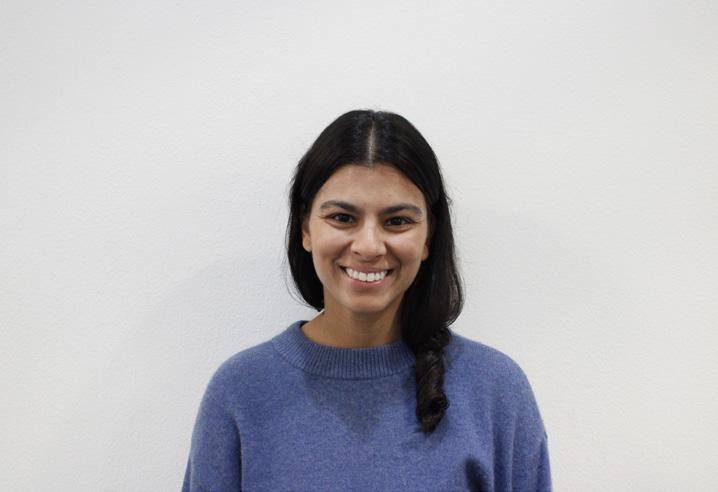
against a nationwide rise in antisemitism and hate crimes in general.
What started as a small act of unity has since expanded to include the Christian Student Coalition and non-religious students.
“Last year, a lot of my friends who were not part of any specific religious affinity group came to talk to other people and share experiences,” said senior Iliyan Ali, vice president of the Muslim Student Association.
Details of Event
Leaders from the Muslim, Christian and Jewish student groups coordinate to choose a day for a lunch. To help create a welcoming space and attract more students to join, faculty sponsors order pizza and other treats for attendees.
“Sometimes people are too busy and have work to do so we have tried to advertise it more to our friends and provide a good incentive like pizza for people who show up,” said senior Soyam Kelifa, a Muslim Student Association co-

Student leaders also work together to compile discussion questions and themes for each
“We’ll start with a list of questions and things to just sort of get people talking and thinking,” said senior Ruby Garza, co-president of the Jewish Affinity Group.
“But typically, in my experience, things branch off
The lunch is designed to be a casual place for students to engage in productive

dialogue about religion.
“I think all our religions emphasize community, care and loving each other, and I think that this is a good place to talk about that in a low-stakes environment,” Ali said.
Rising Popularity
While many students may be deeply grounded in their own faith, the lunch gives them a unique opportunity to learn about others, according to Garza.
“The conversations I have had at the Interfaith Lunch made me realize how little I actually know about a lot of these religions that I’ve grown up around my entire life,” Garza said.
For many Upper School juniors, seniors and alumni, Bagel Day was a beloved community event. But after former Upper School Dean of Students Jack Oros retired, the tradition was lost.
Hoping to restore the event, the junior Student Council members revived Bagel Day this fall.
“I was definitely disappointed about the end of Bagel Day and others among the upperclassmen were too,” said Junior Class President Paylin Barnes. “It was a very good social event to get all of the Upper School together.”
When the sitting junior Student Council members were elected at the end of the 20242025 school year, they collaborated with Junior Class Dean Emily Myhre to discuss the topic of restoring Bagel Day.

members ran into some logistical roadblocks similar to those that a previous attempt had the year prior. That attempt was a studentled initiative that moved Bagel Day to the Buzz, the campus store.
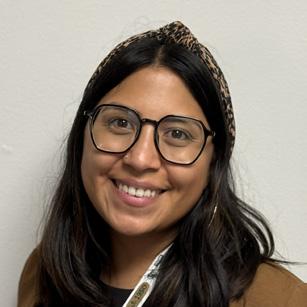
The roadblocks included funding, where the money made from bagel sales went and how the bagels were purchased.
“We had an iteration of it last year and it didn’t land the same way, but this time around it was spearheaded by one of our class deans and because of this it ran a little differently,” said Rivera. When it came time to decide what to do with the profit, Myhre and the class officers chose to use the earnings to pay for the next batch of bagels and put any leftover funds into the class charity fund. Under Oros, the school retained any
An even bigger challenge in the recent effort to resurrect Bagel Day was how to collect money from students.
Ali says that in a time of global tension and polarization, many religious groups are being pitted against one another. This increased the importance of events like the Interfaith Lunch, student leaders said. The event has grown in popularity each year, and student leaders say they hope to keep expanding it to include more faiths and perspectives. The plan is to hold two lunches this school year.
“I think one lunch isn’t going to change the world,” Khan said. “But it’s really rewarding to see students, especially without the direction of the adults, sit down and collaborate in spaces that maybe they don’t identify with.”
“Finding our how to pay for the bagels was one of the most difficult parts of the logistics,” said Myhre. “We were a cashless campus, phones were going to be gone, it wasn’t going to be through the Buzz so people couldn’t use Buzz numbers and the 11th grade didn’t have credit card scanners.”
Eventually Myhre and school administrators agreed that cash would be the easiest solution. As a result, they waived the “cashless campus” requirement for Bagel Day.
The tradition of Bagel Day actually began when Assistant Head of Upper School Rebecca Shuman was dean of students, according to Oros.
We started talking about things we wanted to do this year, and that idea came up.”
The new Bagel Day tradition got underway on Oct. 14 outside the Lecture Hall in Upper School South (Fulton Building). Various Upper School advisories have run the three Bagel Days as of Nov. 4.
“It’s a cool way to bring people together,” said freshman Emmett Considine. “It was a smooth, pleasant and fun experience.”
Sadie Werner
Noah Stinchcomb, John Hurley
Graphic by Dani Reiman
Kira Rivera
UNITING RELIGIONS: Muslim, Christian and Jewish students eat while discussing beliefs. Interfaith lunch meetings began after a 2022 hate crime in Colleyville.
Photo courtesy of Greenhill Communications
Graphic by Lylah Pouratian
Zuff ranieri in Sudoku Championship
Victoria Gonchar
When Upper School math teacher Jason Zuffranieri was a kid, he discovered logic puzzles in his mother’s magazine. She noticed his fascination and started buying him his own.
This is where Zuffranieri encountered his first Sudoku puzzle. It wasn’t love at first sight.
Sudoku is a number-based logic puzzle that challenges players to fill a grid so that each row, column and section contains every digit from one through nine without repetition. Each Sudoku puzzle begins with a few numbers already given, and puzzlers determine what boxes the remaining numbers belong in.
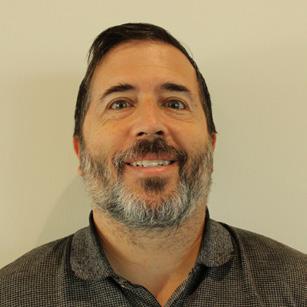
“I hated the very first Sudoku puzzles,” Zuffranieri said. “I wanted to finish the magazine, but these puzzles were so boring and not even challenging.”
Fast forward a few decades, and the Sudoku puzzles that bored a young Zuffranieri became an international craze in the mid-2000s.
“I was doing [Sudoku] every day in the newspaper, and I started to find them quite enjoyable,” Zuffranieri said. “I realized that I was actually pretty good at these things.”
Zuffranieri soon learned there was a U.S. national Sudoku team that competed in a world Sudoku championship. He aced the qualifying process that required competitors to complete 20 puzzles in two and a half hours.
Zuffranieri has gotten the best score on the qualifying test nine times since 2010.
“I tend to do pretty well on these tests,” Zuffranieri said. “I’ve even taken the test from campus twice and won the qualifying round both times.”
The U.S. Puzzle Championship Inc., the governing body of Sudoku competitions in the United States, sends multiple teams to the world championships. The top three competitors in the qualifying process comprise Team A, with the next three competing as Team B and the three after that as Team C.
This year, Zuffranieri got fourth place, so he represented the United States as a member of Team B.
Puzzle Championships
As a part of U.S. Team B for Sudoku and Team C for the puzzles competition, Zuffranieri attended the World Sudoku and World Puzzle Championships in Eger, Hungary, from Sept. 21-28.
The first day of the competition consisted of a Q&A session. Days two and three were Sudoku championship rounds. There was a one-day break before three days of puzzle championships.
The start of the competition consisted of 14 rounds of Sudoku. These included individual and team events, both of which Zuffranieri competed in.
Team rounds include groups of four people each working together to solve their own Sudoku.
“They always come up with some clever way to get everyone on the team to work together,” Zuffranieri said.
There were different variations of team rounds. During one such round, team members couldn’t talk to each other. Each member was given a puzzle but could only solve parts of it on their own. They had to know their teammates’ answers and use them as hints to solve the rest.
For each round of the Sudoku championship, contestants were given 15-20 puzzles that were scored similarly to the qualifying test.
Zuffranieri ended up placing 54th in Sudoku and 94th in puzzles in a competition featuring more than 250 individual competitors in Sudoku and more than 260 in puzzles.
“I’m not really a contender anymore,” Zuffranieri said. “The people who finished ahead of me this year were one-half to one-third of my age. It’s still fun and I’m still proud of all my accomplishments.”
Zuffranieri says these competitions mean more than just the final score.
“It’s about making these connections with different people and entering someone else’s world and learning about them,” Zuffranieri said. “That’s what it means to me.”
Outside of the team rounds, Zuffranieri followed a set schedule throughout the championship.
eat breakfast. The championship rounds would start at 9 a.m. and were 40 minutes each. After all the rounds were concluded, everyone would go to dinner and then do planned activities in the evening.
One of the activities was a music recognition game, where players would have to guess the song before the other contestants. Zuffranieri had won this game at the 2025 championships. He also won this same activity in 2011.
“This is the only activity that I had ever won,” Zuffranieri said. “I was most looking forward to it, and it didn’t let me down.”
Beyond the competition, Zuffranieri enjoys the different experiences and travel opportunities the events provide.
It’s about making these connections with different people and entering someone else’s world and learning about them. That’s what it means to me.”
“The two best trips I’ve had were this year and the one 14 years ago, also to Hungary,” Zuffranieri said. “I really liked that we got to do some sightseeing and go to different castles.”
At the world championship, players get to submit bids of where they would like the next two championships to be held. Next year, the championships will be held in the city of Kolkata (formerly Calcutta), India.
“You really get to see the world,” Zuffranieri said. “I’ve met some of my favorite people at these competitions, since we have a lot of the same interests.”
Sudoku on Campus
Back on Greenhill’s campus, Zuffranieri says he hopes to share his passion with students. While there used to be a Puzzle Club, it never gained new members and eventually everyone graduated.
“Puzzles are a lot more fun to do with other people instead of by yourself,” Zuffranieri said.
He says he would eventually like to restart the club.
“I would love to bring it back, if people wanted to join and do these puzzles,” Zuffranieri said. “I have an endless supply of them and so much more than just the basic ones you have seen.”

Winter Sports Underway
As the fall sports season came to an end with the Southwest Preparatory Conference championships, winter teams began their preseason on Nov. 3 and started getting in condition for competitive play. The season is ramping up heading into the Thanksgiving holidays, with athletes competing across basketball, soccer and swimming.
Admissions Events
Greenhill admissions held its first major preview event on Oct.16 and is set to host a second event on Nov. 16. The admissions team will continue to host school previews for prospective parents and students in the months ahead.
Homecoming Celebrations
The Greenhill community spent Oct. 20-25 celebrating Homecoming Week through school spirit traditions such as Pajama Day and Heart of the Hill group meetings. These celebrations culminated in an all-school pep rally on Friday and a home football game against Houston Christian that night, with the Houston team winning 51-7.
2000 SPC Football Champions
For now, Zuffranieri plays online puzzle games with
Among these games, many of his students favor Heardle, a song-guessing game similar to the one Zuffranieri won, and Dordle, in which players have to guess two words
“Playing games feels like a break from working, but my brain is still focused on something,” junior Nikita Bhasin said. “You can tell he is very talented. He is so good at all
Bhasin likes how Zuffranieri is passionate about things outside of
“It’s so cool, too, that my teacher goes to world championships and applies different skills outside the classroom,” Bhasin
His feats not only impress students but also deepen their respect for him.
“Since he is so accomplished, it makes me trust him more as a teacher,” senior Sarina Rutner said. “I feel like I will
Zuffranieri says he hopes students realize that knowledge is fun, and they will come to share his love for “It’s more than just another game,” Zuffranieri said.

Every morning he would wake up around 7 a.m. and
On Oct. 17, members of the 2000 Southwest Preparatory Conference football championship team celebrated their 25-year reunion at a Greenhill football game. Members arrived before the kickoff on Brinkmann Field and were recognized during half-time.
Improv Troupe Show
Members of the Upper School Improv Troupe performed their first show of the school year on Oct. 29. This show kicked off the holiday season with a Halloween-themed performance in the Black Box Theatre, featuring costumes, Charlie Brown and laughter.
Band and Orchestra Concerts
The Upper School Chamber Orchestra hosted its first concert of the season on Oct. 15. The Greenhill Band followed, opening their year with the annual Pops Concert on Oct. 21.
Nonprofit Fair
The Greenhill Service Board will host the school’s first nonprofit fair on Dec. 9. The fair will feature 30-40 nonprofits for students to plan opportunities for future service.
Interfaith Lunch
Upper School affinity group leaders are preparing to host the school year’s first Interfaith Lunch to celebrate cultural experiences through food and traditions. The date is still being discussed.
Jason Zuffranieri
Greenhill Launches First Nonprofit Fair
Finding volunteer opportunities can be challenging for students, so the Upper School Service Board will be hosting Greenhill’s first Nonprofit Fair on Dec. 9 to simplify the process.
Representatives from 30 to 40 nonprofits across the Dallas-Fort Worth metroplex will be on campus for the fair to advertise their volunteer opportunities and engage with students.
“You can go ask them certain questions, and you can find a place that may be a good fit for you,” Director of Service Learning and Community Engagement Jessica Chu said.
serving on the Service Board. When members reapplied for the board last year, they were asked to come up with ideas on how to expand service on campus.
“I was thinking like, you know how we have club fairs, it’d be super cool if we did that for nonprofits,” said junior Sia Sankaran, who also serves on the Service Board. “Clearly great minds think alike, and a lot of us had the same idea.”
Planning started in October 2024, and the fair was originally set to happen last spring. Logistical issues resulted in the fair being rescheduled for this December.
“The issue was kind of twofold: finding a location that can accommodate that many people, and then not only a location, but a time,” Chu said.

The event will unfold like the popular campus club fair. Nonprofits like Society for the Prevention of Cruelty to Animals, Community Partners of Dallas and Dallas Arboretum will each have their own stations where students can interact with volunteer coordinators to find out how they can get involved.
“Our main goal is for students to find a nonprofit that speaks to them and that maybe corresponds to a passion or hobby that they enjoy,” said junior Anika Katikaneni, a Service Board representative. “A lot of people don’t know about many of the amazing organizations that are out there, so we are trying to bring those organizations to them.”
Taking Shape
This idea originated with students
This extra year has enabled the board to plan the fair more thoroughly and ensure that all the logistical challenges were resolved, according to Chu. Now their main task is finalizing what organizations will be a part of the event.
The board started by reaching out to nonprofits that already host Greenhill volunteers and then branched out to other nonprofits in the Dallas area. Their goal was to find organizations that are credible, open to high school volunteers and connect with the interests of Greenhill students.
“We looked up a lot of nonprofits in the Dallas-Fort Worth area, and we tried to find them from a diversity of locations, because we know the locations of Greenhill students are definitely diverse,” Sankaran said.
Communication with these organizations has also brought challenges. The board ran into issues with getting responses to emails inviting the nonprofits to apply for the fair, and they had to resort to other forms of communication, like direct calls, Sankaran said.


FAIR FESTIVITIES: Service Board members discuss plans for the Nonprofit Fair on Dec. 9. The fair will connect students with new volunteering opportunities.
The leaders of nonprofits are eager to get the chance to share their mission and connect with students personally, according to Chu.
“A lot of nonprofits, if they have a solid base, want volunteers,” Chu said. “They want manpower, and they want people that are excited to invest their time.”
Students and Service
The purpose of the nonprofit fair goes beyond just introducing students to different volunteering opportunities. The Service Board representatives want students to explore their interests and use it to give back to the community, according to Chu.
“They wanted to create this buzz around service, get people excited about service, get people aligned with their passions and how to help their community,” Chu said.
Chu and board representatives say they hope that the exposure to many different nonprofit organizations will introduce these students to real-life issues and motivate them to make changes outside the Greenhill community.
said. “They can inspire you to make greater change than just in school.”
Chu says she hopes students will find motivation and initiative in doing service and volunteering by letting students explore different nonprofit organizations at the nonprofit fair.
“We’re not thinking about an award, and we’re not thinking about a game for ourselves,” Chu said. “Rather, we’re doing it because we’re intrinsically motivated, we care about others and we care about whatever that passion is.”
Ultimately, the Service Board hopes the nonprofit fair will allow students to find enjoyment in consistently giving back to the community, as it is an important part of Greenhill’s culture.
“[The nonprofit fair] is to show kids that there are so many different kinds of community service that they might not

“When you get more into the community, you get to see the realities, facing the problems [that are] facing more of the broader community,” Sankaran
know about,” Katikaneni said. “I think that once they realize that, then they might actually find something that they enjoy and will consistently serve at.”
Vivian White, Naomi Wien
Photo by Naomi Wien
Jessica Chu
Graphic by Lylah Pouratian
Middle School
Emma DeVine
everything online.
Award-winning Middle School science teacher Emma DeVine has returned to Greenhill after a two-year absence.
Earlier this year, DeVine was named a Discovery Education Educator of the Year. In 2022, DeVine was honored as an Outstanding Rookie Science Teacher of the Year by the Science Teachers Association of Texas.
DeVine says she always enjoyed science when she was younger, but she never imagined teaching the subject. Now, she is in her seventh year as a science teacher.
Her teaching career began at the University of Texas at Dallas, where she completed her bachelor’s degree in science education in 2019 and a master’s degree in the same subject in 2021. As a UTD student, she began teaching in the UTeach Dallas Science Mathematics Program.

“I just loved the program,” DeVine said. “I grew to love the classroom and working with kids due to the exposure that I had in college.”
In 2019, DeVine started teaching in the Frisco Independent School District.
She applied for a position at Greenhill in the spring of 2021, during the COVID-19 pandemic. She didn’t have the traditional face-to-face interview on campus, but instead did
“I could even feel through a computer screen that this place was pretty special,” DeVine said.
She taught at Greenhill for two years before moving to Austin for her husband’s work. In Austin, she began teaching science at St. Andrew’s Episcopal School, where she developed curricula as a CDC Science Ambassador and Fellow.
When DeVine moved back to Dallas, she says she knew she wanted to return to Greenhill. A position was available and she was hired.
“I just loved and valued the community and the people here,” DeVine said. “It meant a lot to me to be able to come back to this place.”
DeVine says she cherishes the supportive community and the independence that Greenhill faculty members are allowed in the classroom.
She has been encouraged to share with her students what she learned through her CDC training and from her summer participation in UT Southwestern’s neuroscience STARS Program, DeVine said.
“[Greenhill] aligns with what I value as a teacher and as a person,” DeVine said.
DeVine says she encourages her students to see themselves as scientists one day, even if they don’t go into a science-based career in the future.
“I want my students to walk away [feeling] empowered in their learning [and] to feel authentically connected to the world around them,” said DeVine.
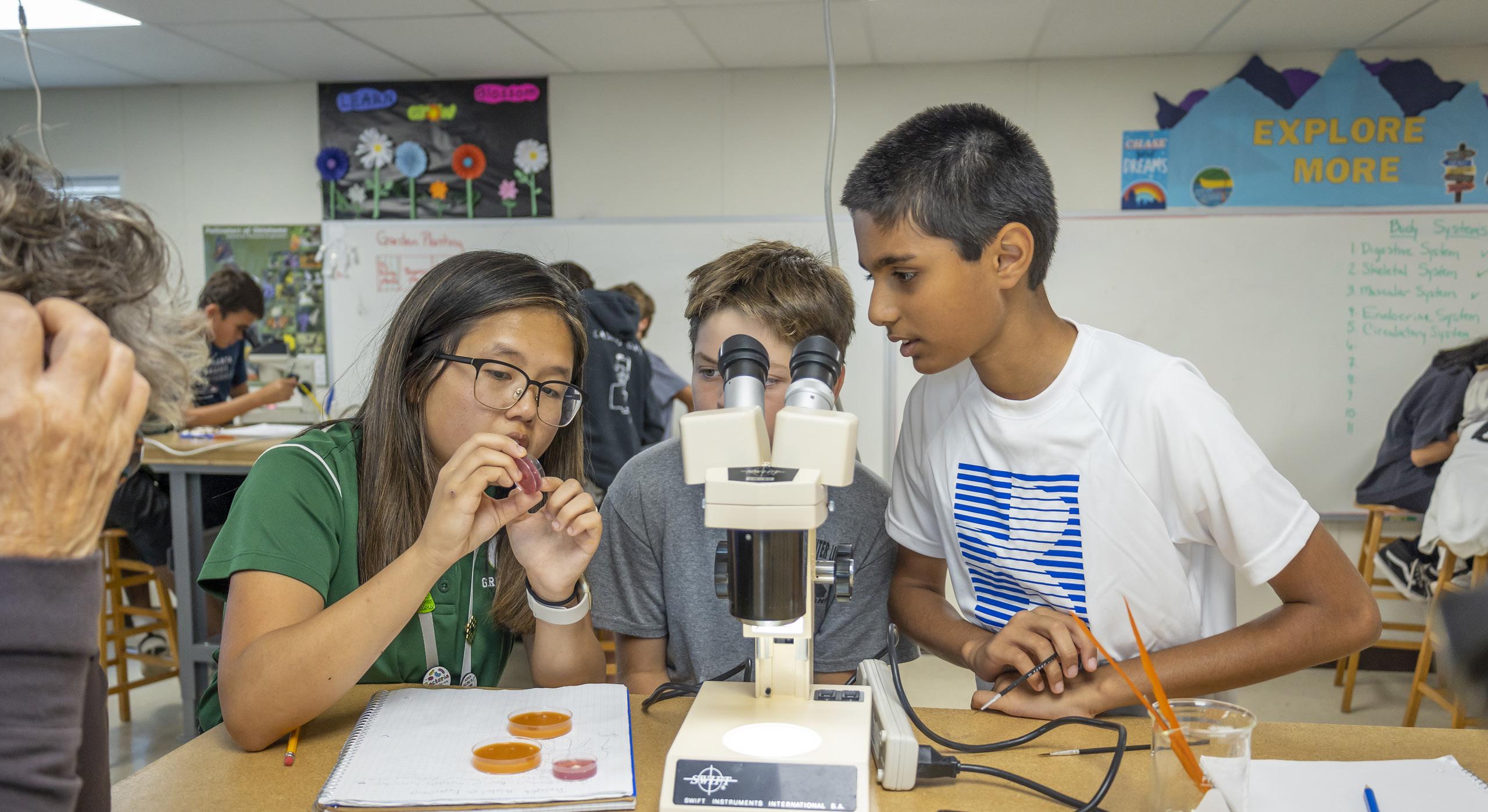
D.C. Visit Amid Shutdown
Julia Bella Frankfurt, Nithya Rao with reporting by Sammar Agha, Lily Schanbaum, Zayla Yousuf and Laura Zaballa
The annual eighth-grade trip to Washington, D.C., took place in early November amid the longest federal government shutdown in U.S. history.
Students were originally scheduled to visit Capitol Hill congressional offices and various Smithsonian Institution facilities and other museums, but most of these places were closed as a result of the shutdown. The schedule was rearranged to emphasize visits to outdoor venues such as the Martin Luther King Jr. Memorial, the Lincoln Memorial, the Vietnam War Memorial, the Korean War Veterans Memorial, the National 9/11 Pentagon Memorial and Arlington National Cemetery.
“I just want to be able to memorialize those who lost their lives,” said eighth grader Aahan Bambri.
In seventh grade, students study U.S. history by exploring the nation’s founding principles and major events that shaped its development. The D.C. trip builds on that foundation by allowing students to see historical documents and monuments firsthand.
Head of Middle School Susan Palmer, Middle School history teacher Kara Smith and Middle School history teacher Paige Ashley led the planning for the trip, coordinating with eighth-grade advisors. The school works with the Close-Up Foundation, a nonprofit civic education organization based in Washington.
“There’s so much more that we hope students will get
out of this trip than just learning history,” Smith said. “It’s bigger than that. It’s more about students finding their place and thinking about how they can enact change in all of the communities of which they’re a part.”
Every year, the eighth-grade trip brings its own challenges, and the shutdown added even greater complications. The trip emphasizes both freedom and reflection, giving students the chance to explore their own interests while learning about history and civic engagement.

“You get to dive into your own curiosities while you’re on the trip,” Smith said. “There’s certain places that we’re seeing and certain things that we’re experiencing but everybody experiences it in their own unique way.”
In the days leading up to departure, students expressed their excitement.
“I’m very excited about the trip,” said Bambri. “I’m excited to see how our government works and basically how our nation was built.”
Students enjoyed the freedom to explore the nation’s capital firsthand and apply what they’ve learned in the classroom to real-world settings.
“I think there will be a lot of educational stuff about it,” eighth grader Aurelio Pereira said beforehand. “I think it’ll also be a fun time to go sightseeing and enjoy life outside of school and really get a new experience.”
MS Pops Concert
Laura Zaballa, Lily Schanbaum
The Middle School Band performed at Greenhill’s annual Pops Concert on Tuesday, Oct. 21, during Homecoming Week.
Led by longtime Upper and Middle School Director of Bands Brian Donnell, band members devoted weeks to polishing their skills and practicing pieces for fall performances. In addition to the Pops Concert, Middle School students performed at fall football games and Founders Day festivities.
The Pops Concert is an event that’s popular with community members. Some audience members bring blankets to sit on during the performances.
“It’s one of my favorite concerts because it’s a lot more informal than something that we do in Rose Hall during the year,” Donnell said. “It’s a nice, casual and informal concert.”

The concert was a memorable night for many students.
“We played a song called ‘This is Halloween’ that was really fun because everyone sang along,” said eighth grader Colette Fredston.
The Middle School band encompasses a range of instruments, including trumpets, trombones, tubas, clarinets, flutes, bassoons, saxophones and various percussion instruments. In preparation for the Pops Concert, Middle School band students perfected a repertoire of light classical music, show tunes and popular music.
“If you’re participating in class 100% and you’re prepared, you’re going to get better and have fun,” said Donnell. “And if you’re having fun, then you’re going to do more.”
Excitement built among band members in the weeks before the concert. Students particularly liked the casual nature of the music.
“I think it’s fun because you get to make music and it’s also cool to see how you can play it like a professional,” said eighth grader Ayelet Reynolds.
Eighth grader Jennifer Regal said she felt confident and ready to show what she had learned.
“I think it’s a fun opportunity to be able to learn fun pop songs,” Regal said.
Some students said playing together as a group eased nerves.
“You have a whole band, so there’s not much you can mess up,” said seventh grader Lucas Deibert. “Others will help you.”
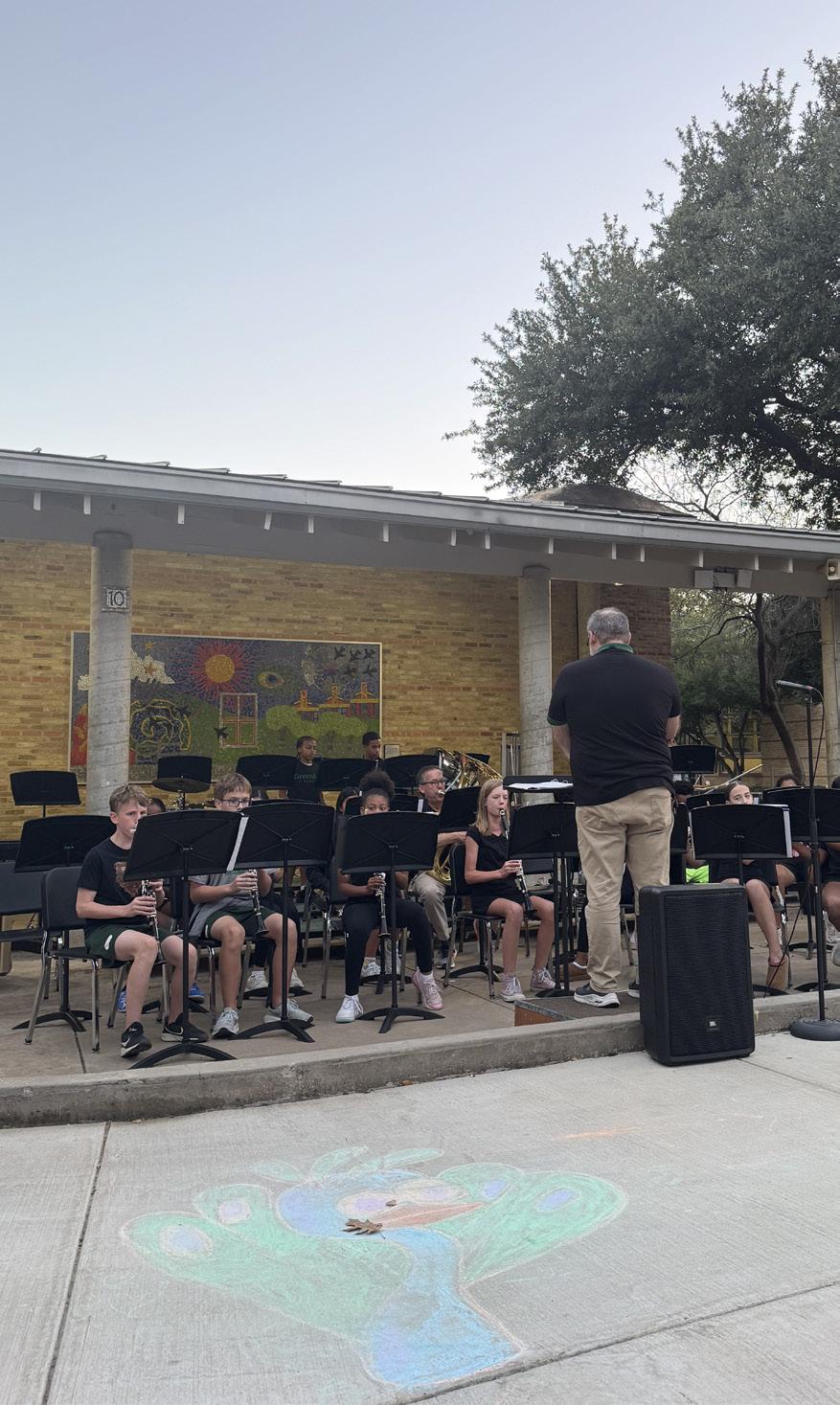
Ana Iwasko
Photo courtesy of Greenhill Communications
UNDER THE MICROSCOPE: Emma DeVine, left, returned to Greenhill this year for her second stint as a Middle School science teacher. She was named a Discovery Education Educator of the year in 2025.
ON THE QUAD: Middle School Band performs “This is Halloween” in front of family and friends.
Photo by Ella Sadka
Emma DeVine
Brian Donnell
Kara Smith
Cindy Chou, Rory Liu
Growing up, Rebecca Kuang ’13 was self-conscious about her speaking and struggled to voice her words. “I think I was just really, really scared,” Kuang told the New Yorker magazine in August.
Kuang’s confidence rose once she became involved in debate. The activity helped Kuang find her voice – a voice that has made her a New York Times bestselling author of six books.
Through debate, Kuang learned about many different fields, from philosophy to history to social policy.
“Knowing all of these things is very good for writing creatively, because it expands the horizons of things that you have questions about and want to represent through your fiction,” Kuang said.
In August, Kuang released “Katabasis,” a fantasy novel that follows two rival graduate students who venture into hell to save their professor’s soul. The protagonists are Cambridge doctoral students who must navigate a world structured by logical paradoxes and philosophical concepts, from Immanuel Kant to Aristotle.
The 560-page novel explores academic concepts completely different from Kuang’s earlier works. But the philosophy she learned in debate remained a foundation for writing “Katabasis,” Kuang said.
“These questions are always lingering in my mind and later, as a novelist, I went back and revisited it,” she said.
Early Writing
University, Kuang was uncertain about her future. She took a gap year in Beijing between her sophomore and junior years and taught debate and rhetoric to Chinese high school students.
In her spare time, she wrote 2,000 words nearly every day. A novel began to take shape. It would eventually become “The Poppy War,” a historical military fantasy based on the Second Sino-Japanese War. It was published in May 2018, after Kuang returned to the United States.
“I was really finding myself, rediscovering my own heritage and language and roots,” Kuang said in a 2021 interview with the podcast Reading Women. “It was a project of exploration and self-discovery.”
At Georgetown, Kuang switched majors three times before settling on literature. She published the final two books of the “Poppy War” trilogy: “The Dragon Republic” and “The Burning God,” which were later nominated for the 2021 Hugo Award recognizing the year’s best science-fiction and fantasy books.
In 2022, while Kuang was completing a master’s degree in contemporary Chinese studies at Oxford as a Marshall scholar, she published “Babel, Or the Necessity of Violence: An Arcane History of the Oxford Translators’ Revolution,” a speculative fiction book about the politics of translation and colonialism.
She published “Yellowface” in 2023,
kept writing, it became clear that this was a
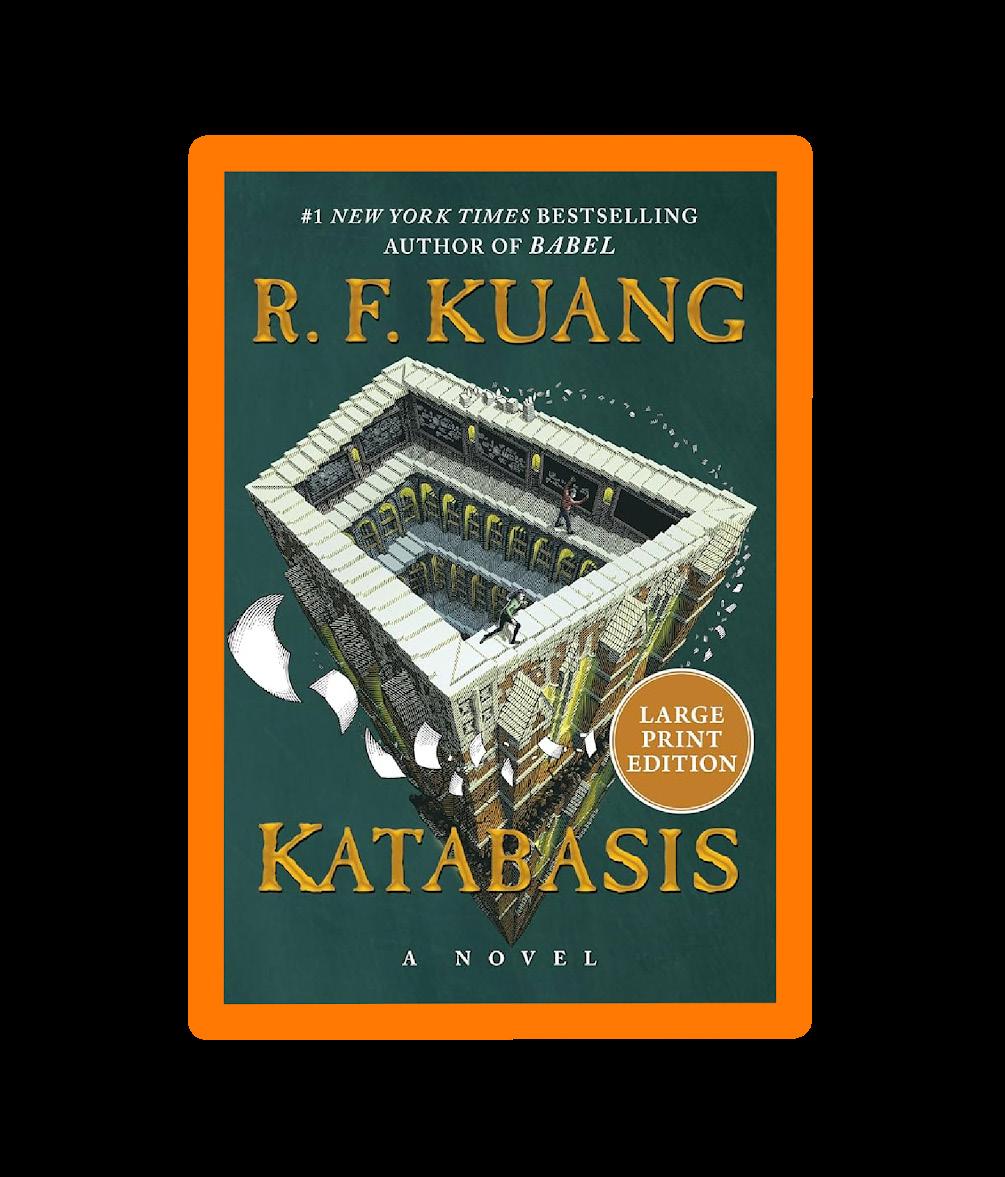

“I don’t have a long explanation for what led me to pursue writing,” Kuang said. “I’ve just always liked it and always did it as a hobby.”
Higher Education
While pursuing a bachelor’s degree in international economics from Georgetown
Kuang weaves in themes about the toxic and competitive nature of academia and the protagonists’ struggle with mental health.
“With this book, it started off as a kind of a light, silly romp through a fantastical version of hell that satirizes the academy because I was in the first year of my Ph.D., and I was poking fun at the social structure around me,” Kuang said in an interview with Virgin Radio UK in September. “But as I
class at Yale on the immortality of the soul.
“I had a lot of fun reading about different cultures and visions of Hell,” Kuang said. “They are so creative and fascinating.”
She often questioned her husband Bennett Eckert-Kuang ’16, a doctoral candidate in Philosophy at the Massachusetts
Institute of Technology who also developed his love of the subject through Greenhill debate. The two first met in Timmons’ office in 2013 and were later married with
Together, they hosted a party with logicians from Eckert-Kuang’s department. Kuang called it a “paradox party,” where each person arrived with a logical paradox they could teach her. Kuang attributed many spells used in “Katabasis” to these discussions, which she called her “ideal kind of party,” according to Publisher’s Weekly.
“Being a novelist is interesting because it requires you to be an expert in a lot of fields you’re not an expert in, and the best way to pretend to be an expert is just to ask smart people a lot of questions and use as much of their language as you can,” Kuang
Showing no signs of slowing down, Kuang has moved on to her next novel, a work of literary fiction called “Taipei Story.” The book explores generational and cultural divides with language, according to Kuang.
In another distinctive trait of Kuang’s writing career, her new work will further expand Kuang’s repertoire of styles and genres. Still, even as she explores new genres in the fiction space, Kuang says her overall philosophy in writing and research
“I just read a lot around a new genre that I’m excited to experiment with until the prose starts to feel natural and seeps into my style through osmosis,” Kuang said. “It started with debate, which asks you to research a bunch of different fields you otherwise wouldn’t know about, and academia serves the same purpose. You take all these classes and read authors that you’ve never heard of, and you just keep chasing questions.”
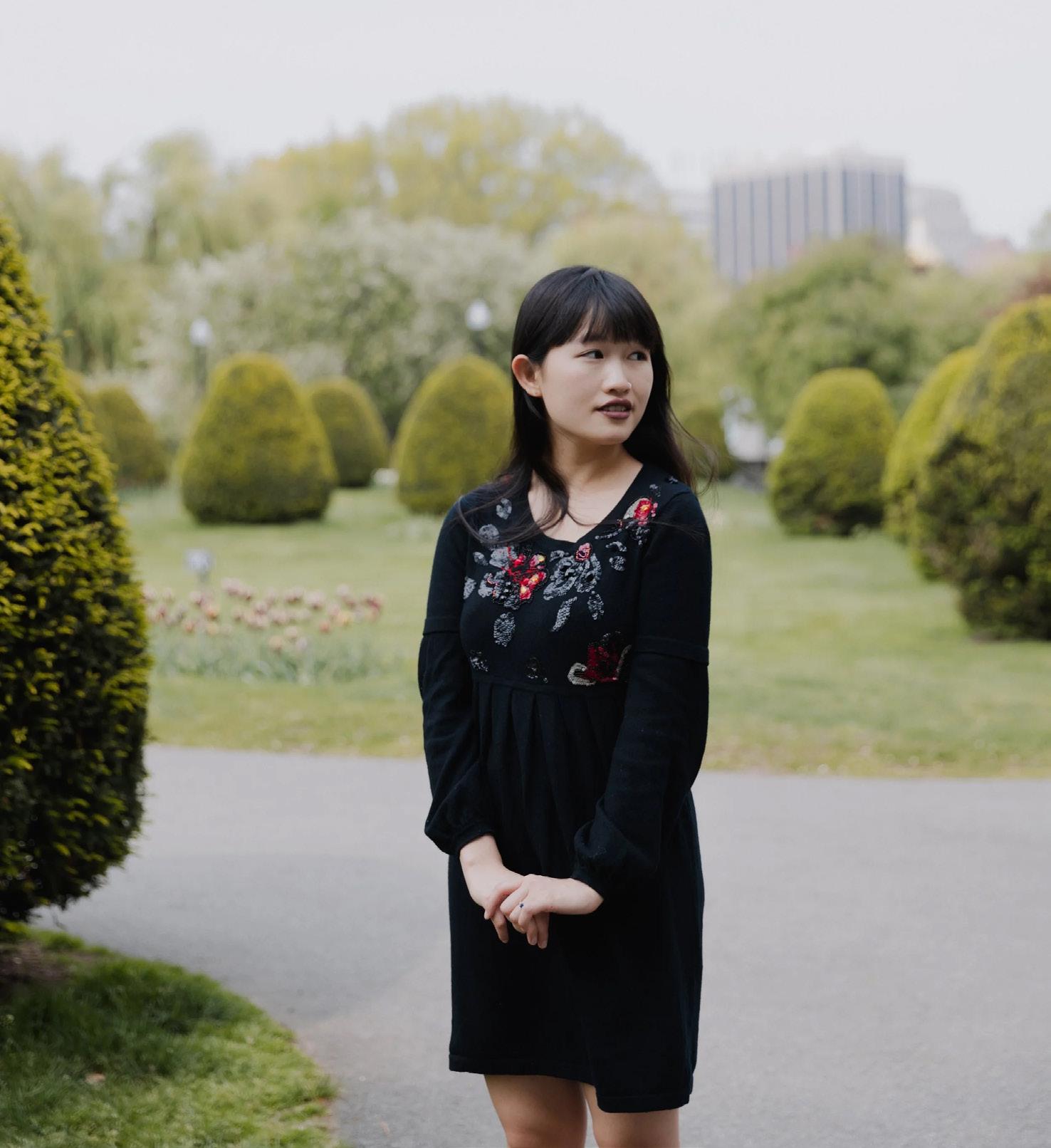
Photo courtesy of Rebecca Kuang
DEBATER TO AUTHOR: Rebecca Kuang is a Greenhill debate program alumna and bestselling author. She released her sixth novel, “Katabasis,” on Aug. 26.
Graphic by Victoria Gonchar Photo illustration by Lylah Pouratian
Greenhill’s Favorite New Numbers
Scarlett Song
Memes have officially left the group chats. They are popping up in math lessons, sneaking their way into Spanish presentations and posing proudly on senior athlete banners.
The phrase “6-7” has taken over social media, but what began as harmless online “brain rot” has now become a national and Greenhill phenomenon.
Originating from the 2024 rap song “Doot Doot (6-7)” by Skrilla, the phrase went viral after NBA player LaMelo who stands 6 feet 7 inches tall, appeared in TikTok edits paired with the song. The random combination of the numbers “six” and “seven” became a meme, spreading so rapidly among Generation Z and Generation Alpha that its exact rise to fame is murky.
The phrase

Erik Park
“If we have a test question and the answer is 6.7, I’ll see six or seven students start laughing for no reason,” Upper School
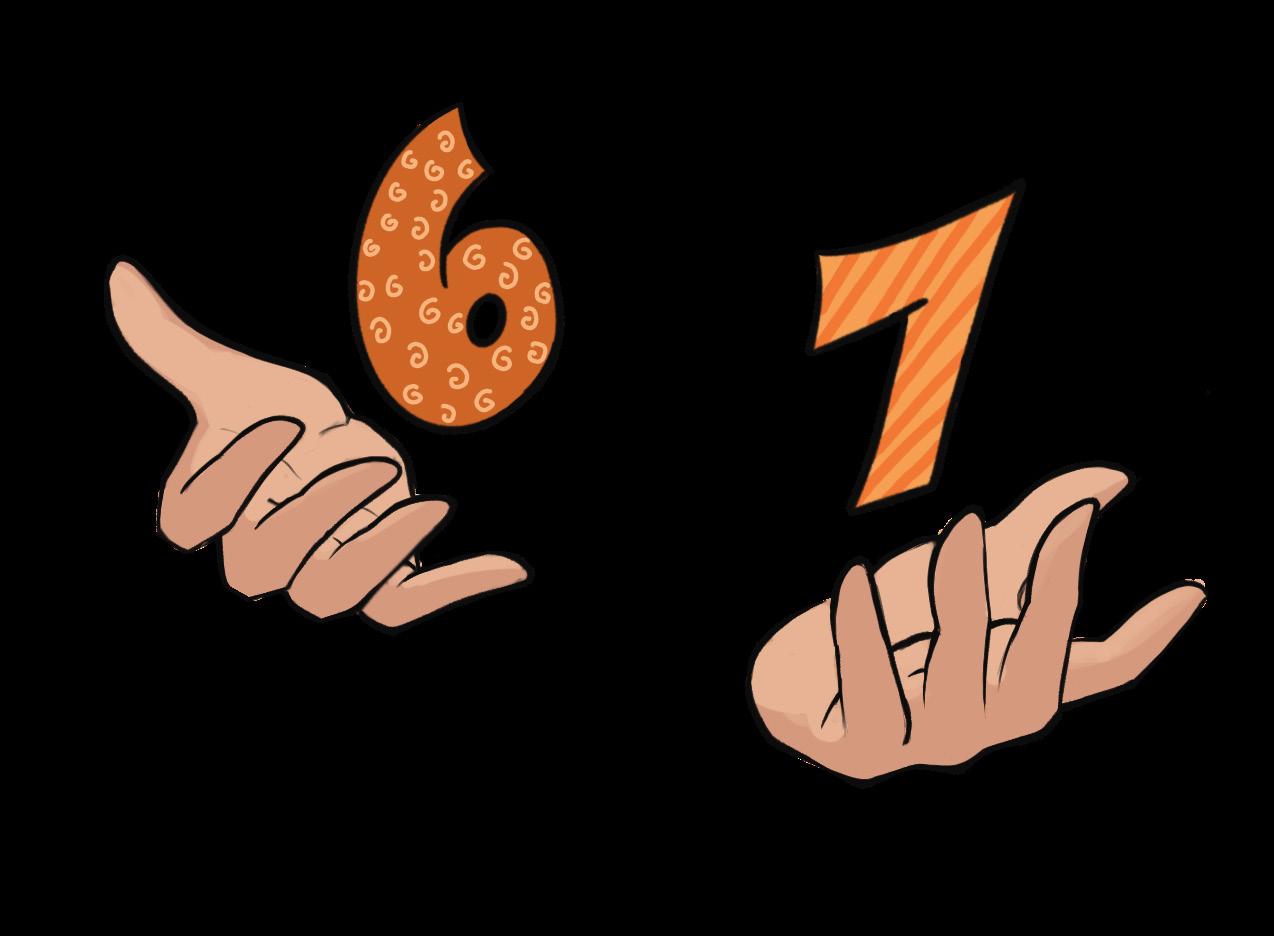
“I love 6-7,” Kirk said. “When someone has the unfortunate timing of saying those numbers together, the laughs that follow are
But other students say the meme has
“It’s very overused and distracting when trying to learn in class,” freshman
In a larger cultural sense, the meme has sparked a broader debate: Is comedy dying in this new digital age? Or simply
Zuffranieri suggests that it may be the
“These things are cyclical,” Zuffranieri said. “When I was your age, we had jokes. It spreads faster because of the internet, and it’s just your generation’s version of nonsense humor.”
For now, the “6-7” meme continues to pop up in Greenhill classrooms. And at least some faculty say that isn’t such a
“If two numbers can make people laugh without hurting anyone, I’ll take it,” said Park. “But maybe in six or seven years, you’ll
The Evergreen Crossword

Crossword by Nora Ahearn and Lylah Pouratian
Graphic by Anjali Blewett
Evergreen
Ella Sadka
Senior Hazel Goes-Young entered Greenhill in ninth grade and quickly established herself as a campus force. She now serves as the Student Council president, dance captain and deputy for the theater program and a member of the debate team.
6:30 A.M.
I tell myself that I will wake up at 6:30 a.m., but I end up waking up at 7 a.m. I do not like to be late for Advanced Placement Environmental Science, so I always rush to get ready. I usually leave the house at 7:30 a.m. I’m still quite tired at this point, so I always try to play really hype music to get my mood started. I end with more mellow or slow songs like “Reunion” by Korea Girl.

9:50 A.M.
I like to go to Starbucks before school. I get an iced chai with one pump of vanilla and vanilla cold foam. That way, it is not too sweet. Today I got the Starbucks Bacon, Gouda & Egg Breakfast Sandwich because I love those. I always park in the Marshall Family Performing Arts Center parking lot. I chill in the Rosa O. Valdes STEM + Innovation Center lobby and talk with my friends. Before I get to class, I write my email to the people that are speaking at the assembly later today to make sure they are

After APES, I usually walk with senior Sarah Koshy or senior Josephina Qiu to my Literature and Detective Fiction English class. I try not to be late, but sometimes I talk with them for too long before class starts. This has been my favorite class so far. I am always fascinated by what [Upper School English teacher] Trey Colvin is saying. Right now, we are watching a movie and discussing how detective fiction is impacted in movies and how suspense is used in books versus movies.
This is the Club I rotation, so I like to go to Political Action Club with junior Max Backover. If I am not going to any clubs, I will find my friends or work on college
11:50 A.M.
I make my way over to the theater. I am a cochoreographer, so I have been working very closely with [Upper School drama and theater teacher] Valerie Hauss-Smith on the musical and adding texture to the dances. I am also a deputy, so I get ready for the day at hand. Often, I stay in the dance hall with [Upper and Middle School dance teacher] Gypsy Ingram to work on dances. I love dancing, so I always have a great time.

Usually, I go off campus for lunch with my friends. However, since we have [an] assembly today, we all just sat at the lunch table. I had to finish eating early to head down to Rose Hall for the assembly to double check the slides and make sure the microphones are
A few minutes before the assembly, I run through the order with the speakers to make sure they are prepared. Once everyone gets settled, I start the assembly and finish off with my hot take of the day. By now, I usually notice that my keys are missing, so I go looking for them after the assembly, but they are usually in my backpack.
[Upper School history teacher] Ayasha Hensen, which is so fun. The conversations are really engaging. Every day it is something new in this class. Right now, we are listening to the oral arguments for the pending U.S. Supreme Court case Chiles v. Salazar because it is a really interesting current event. My favorite thing we have done so far is write decisions like the Supreme Court

4:00 P.M.
I go back to Starbucks or Sweet Hut Bakery and Cafe with my friends and study there for a while. I usually get something to eat and study there until about 8:30 p.m.
8:45 P.M.
I eat dinner, shower and do some leftover work if I haven’t already finished it. I have really been prioritizing sleep lately, so I go to bed at around 10 p.m.
Evergreen Comic
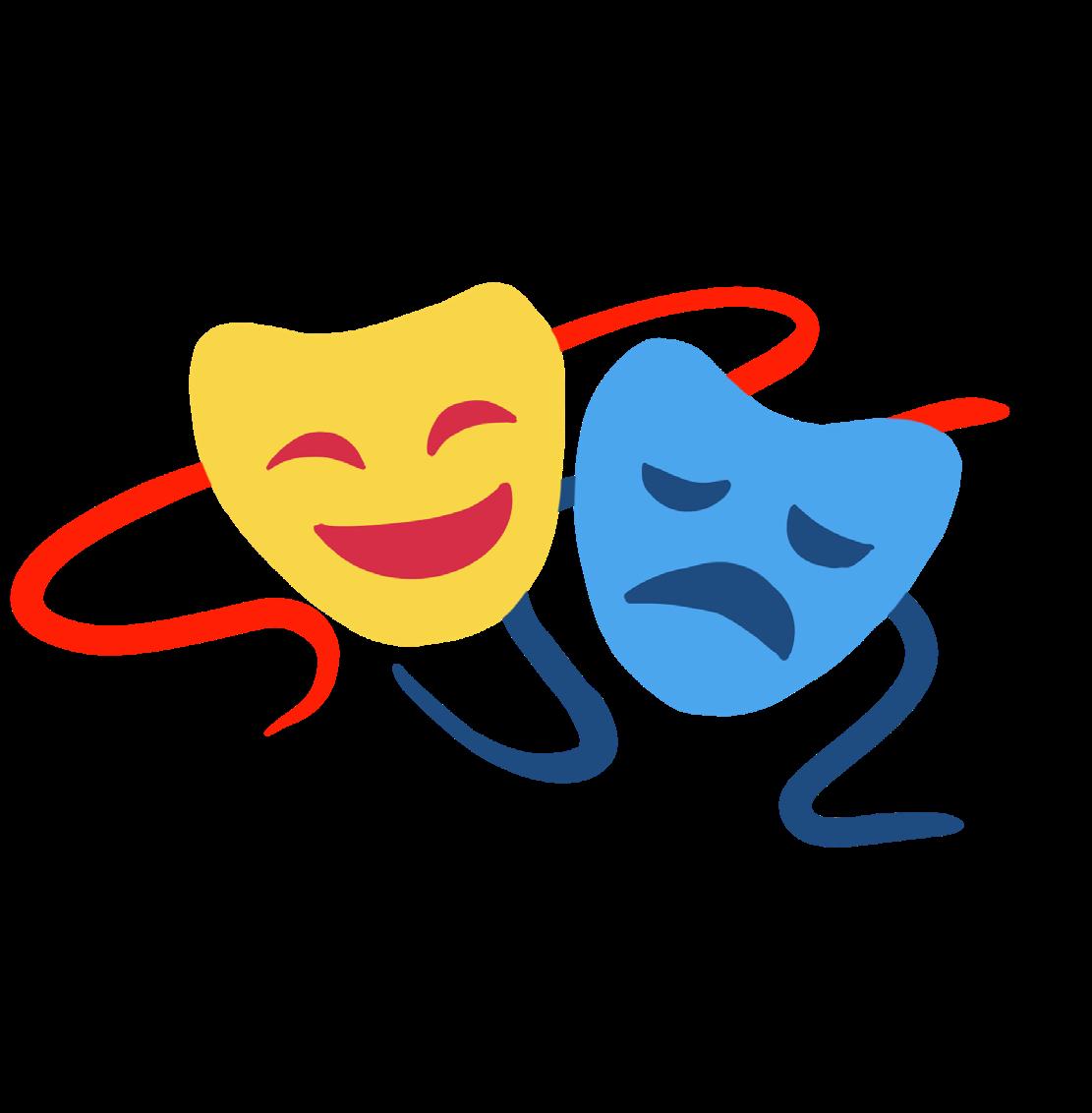

Graphics by Lydia Kerridge and Lylah Pouratian
Comic by Lylah Pouratian
Vedant Subramanian
Junior Niseem Bhattacharya and his friend, junior Aten Biswas, both love cooking.
Beginning with their conversations about favorite recipes, they soon resolved to channel their shared passion into an endeavor that helps others. That’s how their nonprofit, Table of Hope Dallas, was born.
“We saw that most nonprofits or organizations that give food to people in need usually give nonperishable and canned food,”
Bhattacharya said.

Niseem Bhattacharya
“What we did is we started cooking homemade meals at home and then went and distributed them to people in need.”
The nonprofit’s mission is to provide freshly cooked meals to the homeless in Dallas. Since its founding in January, the 501(c)(3) organization has donated more than 250 meals.
“The best thing is when we [distribute] the meals,” Bhattacharya said. “We’ll come back and see that the people are eating our food, and they’re actually enjoying it.”
Challenges
Almost every Saturday, the pair wake up early to cook the meals consisting of chicken, rice and a cookie. They then drive to south Dallas, where they distribute the food.
“Every time we go there, all of the people in need always look forward to the cookies,” Bhattacharya said. “There’s this one
From Cooking to Serving
person, we give him extra because he loves the cookies.”
Formerly, the students distributed food at a tent city on Coombs Street in downtown Dallas. Due to increasing fear of U.S. Immigration and Customs Enforcement raids, many residents left the tent city, prompting the three leaders to move distribution to Cadiz Street, according to junior Ahan Jain, who joined the cofounders as president after volunteering for several months.
“They’re all getting pretty scared now,” Jain said, describing the tent city residents. “There still are tents there, but there’s only maybe 10 people.”
Previously, Bhattacharya and Biswas, a student at Plano West Senior High School, would do all the cooking at Bhattacharya’s house. They’ve since switched to cooking individually and only packing and prepping together.
Jain also cooks as well. With their combined efforts, the group has been able to provide as many as 60 meals in one day’s distribution.
Soon after founding the organization, Bhattacharya says the need for funding became apparent.
“I made the website, we got some footage and we started a big fundraiser,” Bhattacharya said. “We made business cards, and we passed them out. And through all of that, we got a bunch of donations, around $2,000.”
A strong website is key to nonprofit fundraising, something that can be difficult for smaller organizations, Bhattacharya said. UX design teacher Luna Kim helped him design the website.
“It’s hard to compete with the top companies that make insane websites,” Bhattacharya said. “There’s lots of really

small stuff I went through, like designing logos, designing how the layout’s going to look and all of that stuff that I haven’t really done before.”
Future Plans
As the organization looks to expand, Bhattacharya says he plans to begin applying for grants, which tend to offer more money than one-off donations.
“We’ve been going for a while [with] our donation money but it’s running a little low,” Bhattacharya said. “There is going to be a moment where we have to at least get more donations or some more money.”
college, Bhattacharya says they plan to appoint student leaders to organize cooking and delivery and recruit more volunteers.
“I want to make a lasting impact, where we have Table of Hope in this area, and then even when we’re off in college,” Bhattacharya said.
During the Thanksgiving break, the students plan to drive to Houston to host a food drive.
“From there, we’re going to see if we can open a branch in Houston,” Jain said.
The three leaders also plan to make a club at Greenhill and branches near their college and in India through relatives.
“The main principle or idea is to get as many meals to the people in need, because
Finding Community through Baking
Noor Zaman
In the early 2010s, after watching artistic cake baking and decorating shows such as “Cake Boss” on Food Network, Upper School science teacher Emily Myhre baked her first intricately tiered cake for her nephew’s birthday.
After experiencing some challenges with the complex design, she continued to learn about baking and decorating. Now,
Myhre’s first tiered cake has grown into a passion and a buisness.
“As a scientist, I really like baking because it’s chemistry in action,” Myhre said. “Learning something new and experimenting really appealed to me.”
Other faculty members and students have also caught the baking bug.
Third grade literacy teacher Hannah Harkey learned to bake with her mother as a child and has continued since.
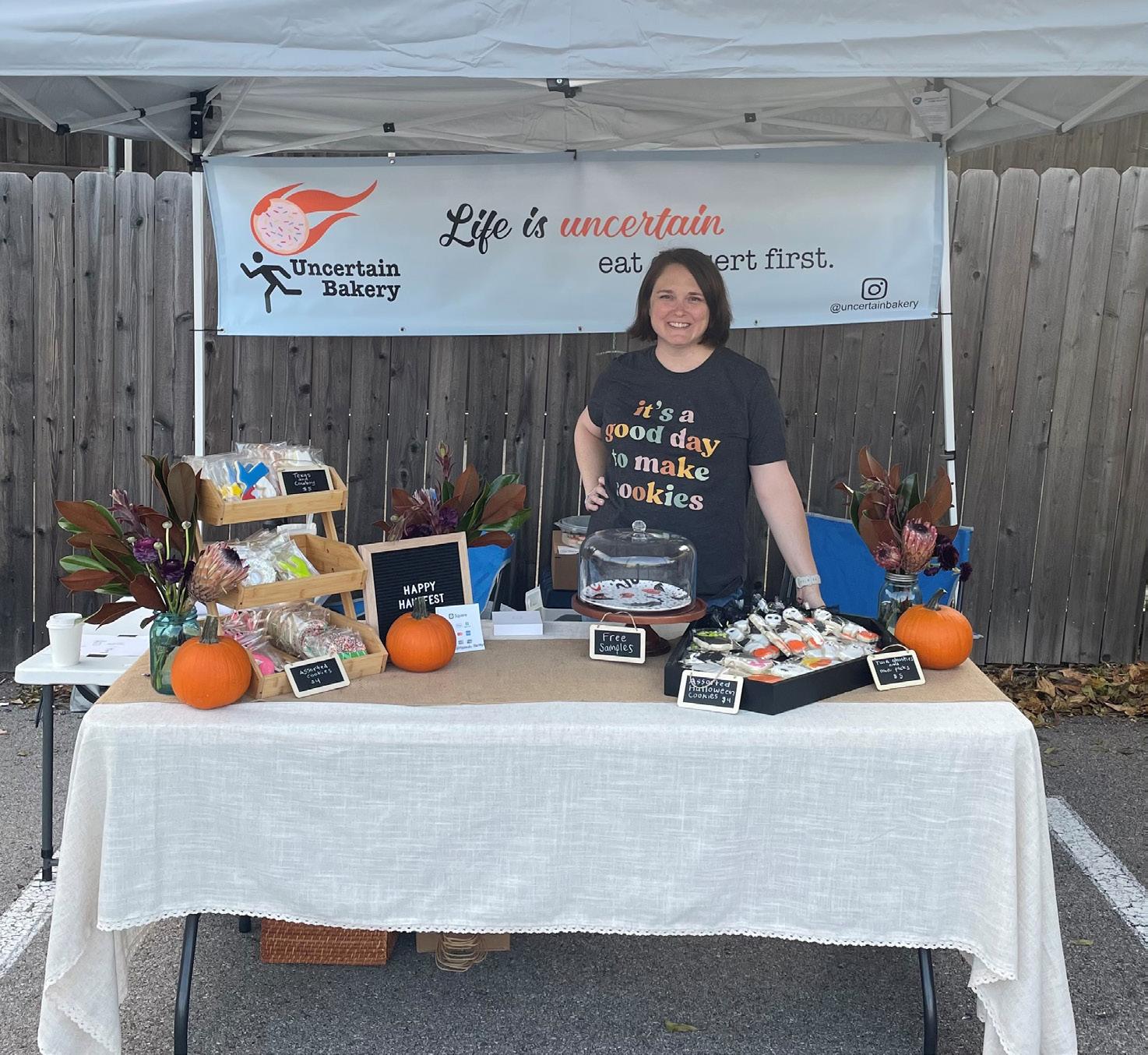


earnings from selling baked goods to Jewish Family Service of Greater Dallas.
“I felt like it was a way to hone my passion while also giving to charity,” Reiman said.
Harkey has followed a similar path. After sharing her treats with her son’s
sweet treats that result from their project, the greater aspect of community inspires bakers such as Harkey and Reiman to continue their craft.
“[Baking] is something that just makes people happy,” Harkey said. “It brings people together and nobody is ever mad about a cookie.”
Photo courtesy of Niseem Bhattacharya
SERVING HOPE: Junior Aten Biswas, second to right, and a Table of Hope volunteer distribute homemade meals to the homeless in a tent city in Dallas.
Dani Reiman
Photo courtesy of Hannah Harkey
BAKE-OFF: Hannah Harkey’s passion for baking led her to start Uncertain Bakery. She sells cookies at events like HausFest, a Dallas Oktoberfest-style celebration. Graphic by Dani Reiman
Arts Fine Arts Roundup
Aanya Bhoria, Noor Zaman
Improv Halloween Show
The Greenhill Improv Troupe held its first show on Wednesday, Oct. 29 at 6:30 p.m. This opening show was Halloween-themed, with troupe members wearing costumes. The event was held at the Studio Theater (also known as the Black Box Theatre), showcasing 11 returning performers and four new members, including two seniors.
“The show went really well, it was a really good time,” said senior Ruby Garza, a four-year member of the troupe. “Doing improv on a stage with an audience at 7 p.m. is so different than at 7 a.m. in a room by ourselves. I still remember my first show, and I could sense that it was a really big moment for the newbies as well. It was really bittersweet as a senior and seeing how fast time flies.”
Other troupe members also enjoyed the performance.
“There were a lot of people there,” junior Hank Maher said. “We were in the Black Box [Theatre], and it was almost full. It’s always fun to do a show.”

Band Pops Concert
The Pops Concert is an annual event where Upper and Middle School Band members come together to play music in a relaxed atmosphere on the Foote Quad. This year, the event took place on Tuesday, Oct. 21 from 6:30-7:30 p.m. Students and band directors began preparing for the event as soon as school opened in August, practicing songs like “Thriller” and “Hocus Pocus,” among others.
“We play music that’s fun to listen to,” Upper and Middle School Director of Bands Brian Donnell said. “It’s a good casual concert and it’s a great time of year to get the kids out there playing. This year it was a beautiful night.”
Band members enjoyed the experience.
“I personally have a lot of fun at the Pops Concert because it’s one of the only concerts where we get to bring out the stuff we play in Drumline other than at football games,” senior Brian Chao said. “It’s a really good event to have at the beginning of the year because it’s more casual than our other concerts which are in Rose Hall.”
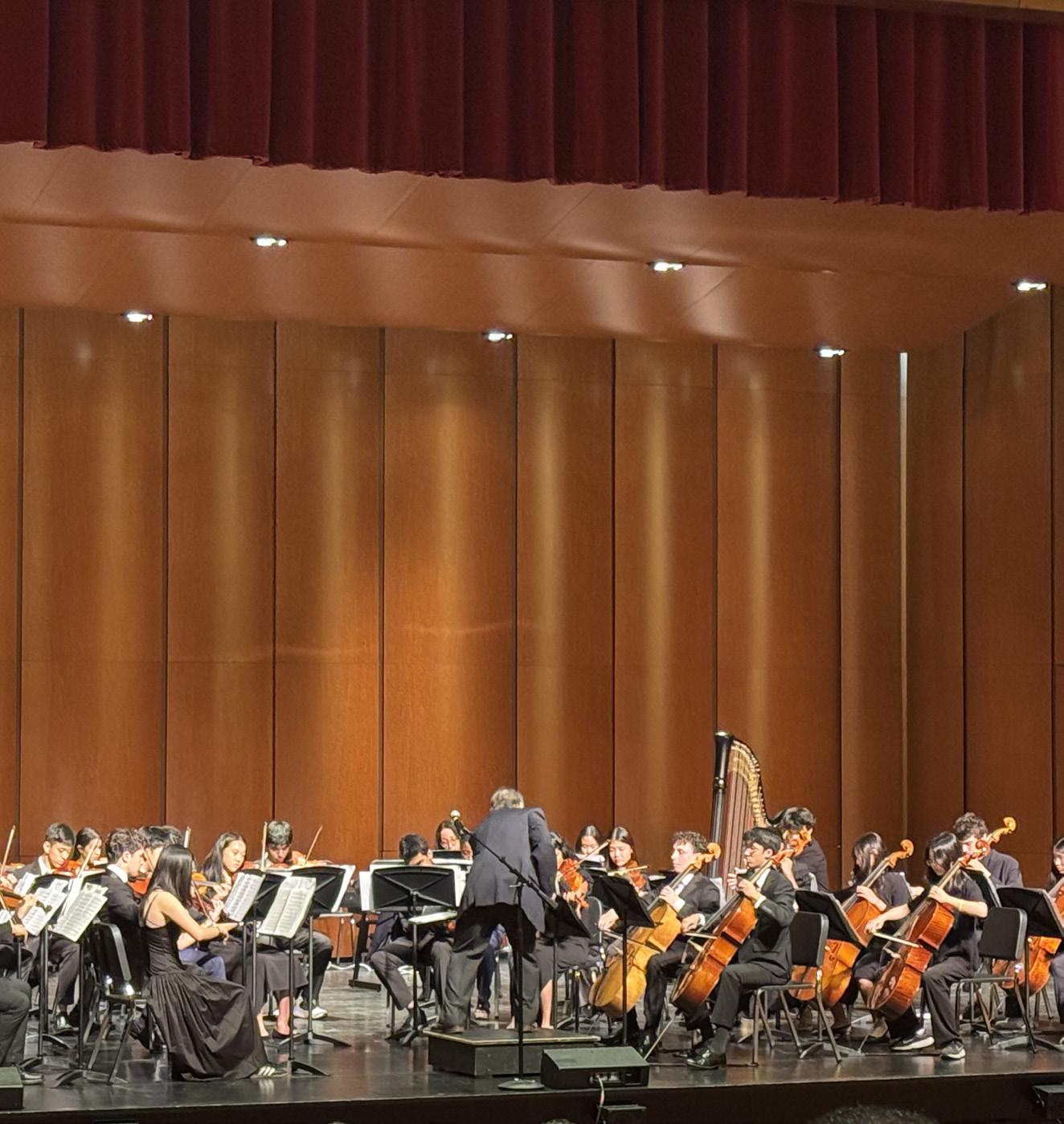
by
Chamber Orchestra Concert
For the past 34 years, Greenhill’s Upper School Orchestra has partnered with Ursuline Academy of Dallas and Jesuit College Preparatory School of Dallas for an annual concert. This year’s event was held at Greenhill on Wednesday, Oct. 15.
The concert originated as a way for the schools’ orchestra members to practice performing and to help students learn music for the upcoming Region 20 Orchestra auditions.
“We ended with an arrangement from the ‘The Sound of Music,’ the musical, and it was just played so beautifully and expressively, and it was such a nice way to end the concert,” Upper and Middle School strings and orchestra teacher Hallie Michaels said. “I think people worked hard and made a lot of progress, and it was a very good performance. So, I was really proud of them.”
The student-performers shared those emotions.
“I’m excited to share our talents and I’m proud of all the progress that we’ve made,” junior Benji Lachar said.
A SPOOKY SET: Upper School Improv Troupe members dress up in festive costumes. Their first show of the year was on Oct. 29 in the Studio Theatre to celebrate Halloween.
Photo courtesy of Owen Hanson
Photo
Lillian Smith
Evergreen
Music as a Meaningful Tool
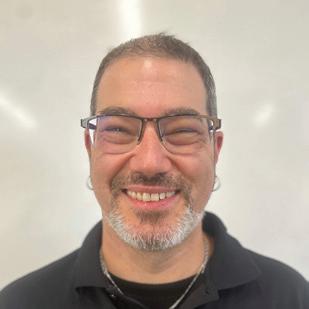
Andy Mercurio
their emotions, whether it is the music that speaks to what they’re feeling, or the music is the opposite
of what they’re feeling, and uplifts them,”
Students utilize music in various ways
While studying, sophomore Kellyn Lonergan often finds herself turning on
“Whenever I start working, I just put in my AirPods and listen to music,” Lonergan said. “I think it blocks out outside noises, and also kind of calms my brain down to help me think and
Beyond baseline listening, music resonates with students’ emotions, according to Czuchlewski. Different artists speak to people in various ways, forming a connection that each student
Czuchlewski says she tries to center her music listening around her
Whenever I start working, I just put in my AirPods and listen to music. I think it blocks out outside noises, and also kind of calms my brain down to help me think and work on school.”

“After a really stressful day at school, I tend to play more music that mirrors how I’m feeling on the way home,” Czuchlewski
said. “Even before school I try to have more happier music just to kind of get me ready for the day, because music really does affect my mood.”
Fanning said. “They’ve become acclimated to the Snoopy jazz,” Fanning said. “That indicates to me that it brings them a level of comfort and helps them to feel comfortable while they’re doing their independent work.”

How Global Artists Are Connecting Cultures
Jin Huang
In recent years, international artists have soared from the status of niche interests to mainstream stars in American popular culture. With the rise of social media, these artists are now easily accessed by fans around the world.
The diverse influence and perspectives from cross-cultural artists bring unique musical styles and build bridges through their art.
“Listening to music from other cultures, especially in different languages, allows you to hear a lot of different types of music styles,” senior Hazel Goes-Young said. “You can see where a lot of Americanized music styles come from.”
K-Pop
Led by the rise of the global phenomenon boy band BTS, Korean pop has gained significant recognition in Western media.
Junior Lucy Kim, a fan of BTS and the girl group BLACKPINK, says it was difficult to be a K-pop fan in middle school because it was often seen as weird. However, the vibrant music videos and the diverse sounds kept drawing her back.
“It also helps me feel in touch with my Korean side,” Kim said. “I bond over that with my Korean friends at church.”
In August, “KPop Demon Hunters,” a film that follows a Korean girl band who uses singing to fight demons, gained popularity around the United States. It drew global attention to Korean pop culture and topped
325 million views by the end of October.
“I was originally not a big fan of K-pop,” senior Kendall Johnson said. “But, the movie was really good, and the songs in it really resonated with me.”
Bollywood
While most Western and K-pop songs are standalone, Bollywood music is typically part of a film and often features dramatic tempo shifts that reflect the storyline, according to senior Dhiya Hemchand.
“The music is so energetic and fun to dance along with,” Hemchand said. “I listen to it a lot with my family.”
Bollywood music has reached a wider audience
collaborations, such as the song “Sapphire” by Ed Sheeran and Arijit Singh, an Indian artist.
“I’m definitely seeing more connections and would love to see more of that in the future,” junior Nirvan Bhattacharya said. “The music is good, especially some songs.”
Chinese Music
Senior Ian Wu says he enjoys music from both Western mainstream artists and Chinese artists.
Beyond. That inspired him to experiment with that genre.
“Chinese singers have a different style in their music than American artists,” Wu said. “I do feel like I have more options depending on what the style and the vibe I want to listen to at the moment.”
Latin Music

Along with his parents, he grew up


Latin music is the fastest growing genre on streaming services in the United States, according to entertainment analytics company Luminate. “Ay Vamos” by Colombian singer J Balvin, for example, had over 2 billion views on YouTube by the end of October.
“Since some of those artists weren’t as popular in America, many people don’t understand that they’ve already been very big in Latino countries,” Goes-Young said.
For the upcoming Super Bowl LIX, Puerto Rican rapper Bad Bunny will headline the halftime show, bringing Latin music to one of the most-watched events in the United
Latin music began influencing some students long before it hit the mainstream, as Spanish songs were a constant presence throughout their upbringing, according to junior Ibrahim Abdelfattah.
“Having that aspect of music from my culture makes me feel at home, especially since I can’t see [my family] that much anymore,” said junior Ollie Melgarejo, who traces his heritage to Peru.
Photo illustration by Nora Ahearn
Appropriaton or
Jordan Arbuckle, Kaitlyn Yoo,
Vivian White
Student Council officers were exchanging Homecoming Week ideas when the theme of “City Lights” first surfaced. The concept and its colorful decorations became one of three themes presented to Upper School students for a vote.
At an Upper School assembly, students cheered as each theme and its associated spirit days were presented. One of the dressup days for “City Lights” was East vs. West, envisioned as an opportunity for students to wear attire representative of America’s East Coast or West Coast cultures.
“I don’t think cultural appropriation or stereotyping was ever part of our thinking,” said senior Jin Huang, the Student Council secretary. “We have a certain level of trust in our student body that people will consider that themselves and will not abuse that freedom.”
“City Lights” and its dress-up days, including East vs. West, received the most student votes for this year’s Homecoming theme. And that’s when the trouble started.
By several accounts, based on Evergreen interviews with students, faculty and administrators, an Upper School teacher raised concerns that the East vs. West day might result in students wearing clothes, accessories or hairstyles that could be construed as offensive acts of “cultural appropriation.”
Huang says she and Dean of Student Life Kira Rivera decided to replace the East vs. West dress-up day with Los Angeles Surfers vs. Texas Wild West and to have a second vote for the Homecoming theme with the new dress-up day included. Following the run-off vote, the theme of “Tropical Getaway” emerged as the winner.
The turn of events surprised some Student Council members who saw an East vs. West day as just another light-hearted expression of school pride and individual tastes in the Greenhill Homecoming tradition. Other council members say they now understand the concerns about “cultural appropriation” raised by at least some adults involved in the Homecoming discussions.
The confusion and conflicting views are a microcosm of the ongoing debate on the subjects of cultural appropriation and appreciation in schools and online forums across the country.
That debate has taken on a sharper edge – and higher stakes – at a time when the Trump administration and its far-right allies have gained the upper hand in a campaign to roll back diversity, equity and inclusion programs in corporate and educational spaces across America.
Cultural appropriation – how it’s defined and whether it’s even a valid societal issue – is an offshoot and active battleground in the right’s war against DEI initiatives and America’s ongoing culture wars over values, beliefs and lifestyles.
“I think these things can get a little muddled, and students kept saying ‘it makes no sense to change [Homecoming] themes,’” said senior Hazel Goes-Young, the Student Council president. “I can get that, but at the same time, we have to understand our places in a broader society.”
Cultural Appropriation
The debate over cultural appropriation and its related concept, cultural appreciation, starts with any attempt to define the two.
According to Oxford Languages,
cultural appropriation is an “inappropriate adoption of the customs, practices, ideas, etc. of one people or society.” The related concept of cultural appreciation is defined by Oxford Languages as “the mindful and respectful interaction with another culture.”
While these terms appear straightforward on paper, they have been central to a long history of controversy, starting with the introduction of the concept of “cultural colonialism” in 1976. Coinciding with the popularization of critical race theory, historian Kenneth Coutts-Smith’s essay on the matter provided a first glimpse at the debate.
But the identification of appropriation of cultural elements, especially in relation to the history of Western colonization, did not provide an objective system with which to classify such acts. Rather, it opened a new area of cultural and historical debate that has since seeped into modern politics.
“People in the United States can’t agree on what cultural appropriation really means and who should get to define it,” senior Soyam Kelifa said. “And this steers away from the real issue, making the debate less about culture itself and more about whose definition is correct.”
By heightening the ideological debate over national values, the controversies over appropriation and how it is defined have continued to fuel culture wars.
Even at a school that embraces diversity, equity and inclusion initiatives and its related concepts, the definition and interpretation of cultural appropriation is still unclear. On campus, some students believe the line separating appropriation and appreciation is thin and flexible. Others see it as more definitive.
“They are definitely very distinct and while there’s a lot of people who say it’s arbitrary, I kind of disagree,” Kelifa said. “There’s a pretty good way to figure out which one you’re doing and what not to do. A lot of people think intent is more important, but I think that impact is more important than intent.”
The topic of intent versus impact circulated around this discussion, and some students disagree on which sentiment holds the most weight.
To senior Hank Utay, many people – especially in online culture – tend to flag anyone who embraces other cultures as appropriation. But Utay disagrees with that definition.
“They say imitation is the sincerest form of flattery, so I would say, if your intent is positive, I don’t think that would be cultural appropriation,” Utay said. “However, if your intent is to actually mock the culture, then that’s where I would draw the line.”
While it is necessary to be conscientious when taking part in other cultures, it is simultaneously difficult to adhere to everyone’s expectation of cultural respect, students and faculty said.
“It’s not that you have to go through life making all of your choices based on what you think someone else might think, but it’s the idea of kind of riding that fine line and being thoughtful,” Upper School Learning Specialist Grace Kiang said.
Student Activities
No matter how disputed these terms are for Greenhill students, the attempt to recognize and celebrate cultures has not been suppressed, even amid national
pressures.
On Jan. 31, the eve before Black History Month, the U. S. Department of Defense announced that military branches would no longer use official resources to host celebrations or events related to cultural awareness months.
For many students, this raised frightening questions about the future of cultural appreciation, not only nationwide, but also at Greenhill.
“I think recognizing these holidays and recognizing these months, especially with what’s going on currently

or Appreciation?
Homecoming Concerns
Even as the Homecoming theme “Tropical Getaway” replaced “City Lights,” in part due to cultural appropriation concerns, another dress-up day sparked discussions.
Director of Equity and Inclusion Monsie Muñoz ’05 says she worried that the day Country vs. Country Club could possibly perpetuate sentiments of elitism and stereotype specific groups of people from different socioeconomic backgrounds. These concerns were then conveyed to the Student Council officers, who worked with Muñoz to alter the name to focus on a theme

“I think when you talk about groups of people specifically is when it gets dicey, because you’re talking about people at Greenhill that are representing populations that we don’t really know everything about,” said senior Kendall Johnson, the Student Council vice president.
“So, with ‘Tropical Getaway,’ we don’t want people to represent Hawaiians, we want them to represent the beach
The name Denim vs. Khaki was then decided upon. However, students are still divided on whether
“For Country versus Country Club, I don’t think the decision is valid,” senior Aiden White said. “It’s just dressing how people in those areas dress. It’s not really cultured; it’s just the type of fashion sense and These conversations about cultural appropriation have also transcended Homecoming.
On Oct. 15, the Upper School Student Inclusion Council hosted the annual Dallas Area Belonging Organization meeting for high school students from independent or private schools in the area.
The meeting’s theme was cultural appreciation versus appropriation and challenged attendees to form a better understanding of the nuanced difference between the two terms, Muñoz
“The organization talks a lot about diversity, and I think a big part of that is appreciating each other’s identities and appropriating is the complete opposite of that,” junior Paylin
In the primary activity, one side of the room
was labeled appreciation and the other appropriation. An image or video was displayed, and students congregated to the side of the room they felt the scenario fell under. Then, they shared why they made their decision.
The conference gave students more clarity on how to lead their lives without appropriating others’ heritage, sophomore Samy Santosh said.
Others said they found hearing differing voices to be valuable.
“I don’t think everyone has the same unanimous perspective, which was really cool because we got to hear other people’s perspectives which challenged our own,” sophomore Gitanjali Agastya said.
Broader Impact
Another way students are exposed to multiple perspectives is through social media. While various platforms offer a diverse range of cultures, algorithms spread trends rapidly and infectiously to consumers, often creating a space of what critics consider cultural ignorance.
Fashion is such an area.
Each year, social media influencers and viewers establish a dress code of what’s “in” that season. For the summer of 2025, it happened to be an outfit accessory referred to as a “Scandinavian scarf.”
Taking the internet by storm, these long, often-colorful scarves showed up at music festivals and vacation dinners.
But they also gained a negative connotation for some. Many felt the accessory closely resembled traditional Indian scarf-like shawls known as dupattas.
“It’s just very weird when people called that clothing piece ‘Scandinavian,’” sophomore Arhaan Iyer said.
Social media can provide a place for creators to use their platforms to teach others about traditional practices and share what makes their culture unique. But the hot-take and confrontational nature of social media also distorts and misinterprets the original intent behind a cultural trend.
Given the ever-present threat of online public shaming for controversial acts by public figures and brands, people are often hesitant to engage with other cultures for fear their intentions will be misunderstood.
However, culture-sharing has also historically provided the means to grow a community, bringing new awareness to the larger population. Recognizing where specific trends originate can facilitate that process.
“A lot of times, culture is where a community’s survival comes from, especially if it’s a minority and there’s not a lot of awareness about their culture,” Kelifa said. “Appreciation of that culture helps keep it alive.”
Over the years, students like Iyer have noticed the rise of other forms of appropriation like the usage of African American Vernacular English, or AAVE, among people who are not Black, henna being used to dot on fake freckles and aguas frescas rebranded as “spa water.”
These trends do not always get labeled as offensive, yet they can have harmful effects on cultures, Goes-Young said.
“Certain trends can take off without people knowing where it came from,” GoesYoung said. “And despite this new thing being popularized, the culture it came from won’t get credit for it.”
This phenomenon can be specifically seen in the African American community,
where aspects of their culture have been repeatedly appropriated, according to Goes-Young. For example, Generation Z has popularized the use of AAVE. Several Greenhill students use words like “bet” and “finna.”
This introduces a racial double standard. While the appropriator gets a pass for the use of this language, the people of the very community being appropriated can be scrutinized for the same actions, Kelifa said.
Because most trends are not as largescale, influencers and internet activists cannot seem to make up their mind on this distinction, with examples alternating between appreciation or appropriation.
One of the reasons many trends are described as cultural appropriation is due to how quickly they get adopted. With how fast trends go viral or wither on social media, it is likely people struggle to fully understand someone’s culture before engaging with it, Muñoz said.
“I think that if we see something aesthetically pleasing and it looks beautiful, we want to be part of that,” Muñoz said. “So then if someone is trying it out because it looks cool, without knowing its origin, that often results in an appropriation.”
In other words, the frequent ignorance in following a trend allows for cultures to be appropriated, as seen through the “Scandinavian scarf.” While the original influencers recognized the South Asian culture, trend followers still misused the accessory, hence, the appropriation.
Even before social media consumed society, controversies arose over the manipulation or erasue of cultures in the United States. The most notable examples involved Native American cultures. While not a direct form of appropriation, the 19th-century practice of uprooting Native American children from their homes and sending them across the country to boarding schools to undergo assimilation into white, Anglo-Saxon culture was largely uncontroversial at the time, but is now viewed with disapproval or even outrage.
More recently, in 2020, the clothing brand Madhappy released a sweatshirt with an emblem closely resembling the Navajo Nation seal.
“I think these symbols and clothes are a part of a lot a cultures’ livelihood, so misusing it often erases people too,” Kelifa said.
But beyond the cultural effects of the colonization and systematic extermination of Native American cultures, America’s history of welcoming immigrants, at least during certain periods, has continued to be a catalyst for sharing cultures.
“I mean, our nation is embedded in so many cultures; we’re a melting pot,” Upper School English and Language Arts Department Chair Karin Thomas said.
Greenhill, a school primarily founded on principles of diversity and inclusion, likewise embodies the notion of a “melting pot” by welcoming a broad range of cultures as well as a range of thinking and mindsets. By fostering hard conversations, Greenhill facilitates positive discourse, bringing national struggles down to a more relevant level, according to White.
“You always need to be eager and open minded to learn about other people’s cultures and appreciate it,” White said. “And as long as you’re not overstepping that line and trying to appropriate it, then there’s nothing wrong with that.”
Graphic by Lylah Pouratian
14 Special Report STARS Students Shine
Petri dishes over pool days. Early mornings over sleeping in. Stepping into the lab instead of wading into the sea.
For two rising seniors, summer meant delving into professional biomedical research through UT Southwestern’s highly selective high school research program.
The eight-week Science Teacher Access to Resources at Southwestern – commonly known as STARS – immerses students in real-world research alongside their principal investigators at the UTSW Medical Center.
This past summer, seniors Natalie Johnson and Shriya Nadagouda spent full, paid workdays learning from their respective principal investigators and mentors.
“I think my PI did a really good job of preparing me to give my presentation,” Johnson said, using the shorthand term for principal investigators. “Every week, she would have me discuss what I’ve been doing for this project and what questions I may have.”
The STARS program is designed to give students without prior research experience or access to such opportunities a chance to work in a professional laboratory setting, according to Upper School science teacher Treavor Kendall.
“The great thing about this program is it will really give you a nice, legitimate, authentic introduction to that world,” Kendall said.
As the former Upper School Science Department chair, Kendall played a significant role in the STARS application process at Greenhill.
Selection for STARS is a multi-stage process.
First, students submit an application on the STARS website that incorporates written or video essays, teacher recommendations, personal statements and an experimental design. Then, the compiled list of applicants is sent back to Greenhill and reviewed by Upper School science teachers, who serve as the initial admissions committee.
The science teachers narrow applicants to five students who proceed to the interview stage with UTSW STARS faculty.
immunology, and I got paired with cellular biology,” said Johnson.
Kendall says the program is a big commitment for the selected students.
“I don’t advise folks who are just sort of looking for something, not to be cynical, but something to put on your resume,” Kendall said. “You really need to have interest in at least attempting to do research.”
Kendall says it’s difficult to thrive in the STARS experience without authenticity and self-drive.
“To be successful in the program, you got to be driving the thing,” Kendall said. “You’re getting up at 7 a.m. in the summer. You’re going to work. It is literally a job.”
Tracking
After being paired with cellular biology, Johnson tracked the cryptic movement of a cellular receptor known as GPCR84. While the receptor is typically found on the cell surface, Johnson’s lab investigated how activation triggers an unusual process in which GPCR84 migrates into the cell and the implications of that migration.
Johnson was placed in a lab that was a part of the Department of Internal Medicine
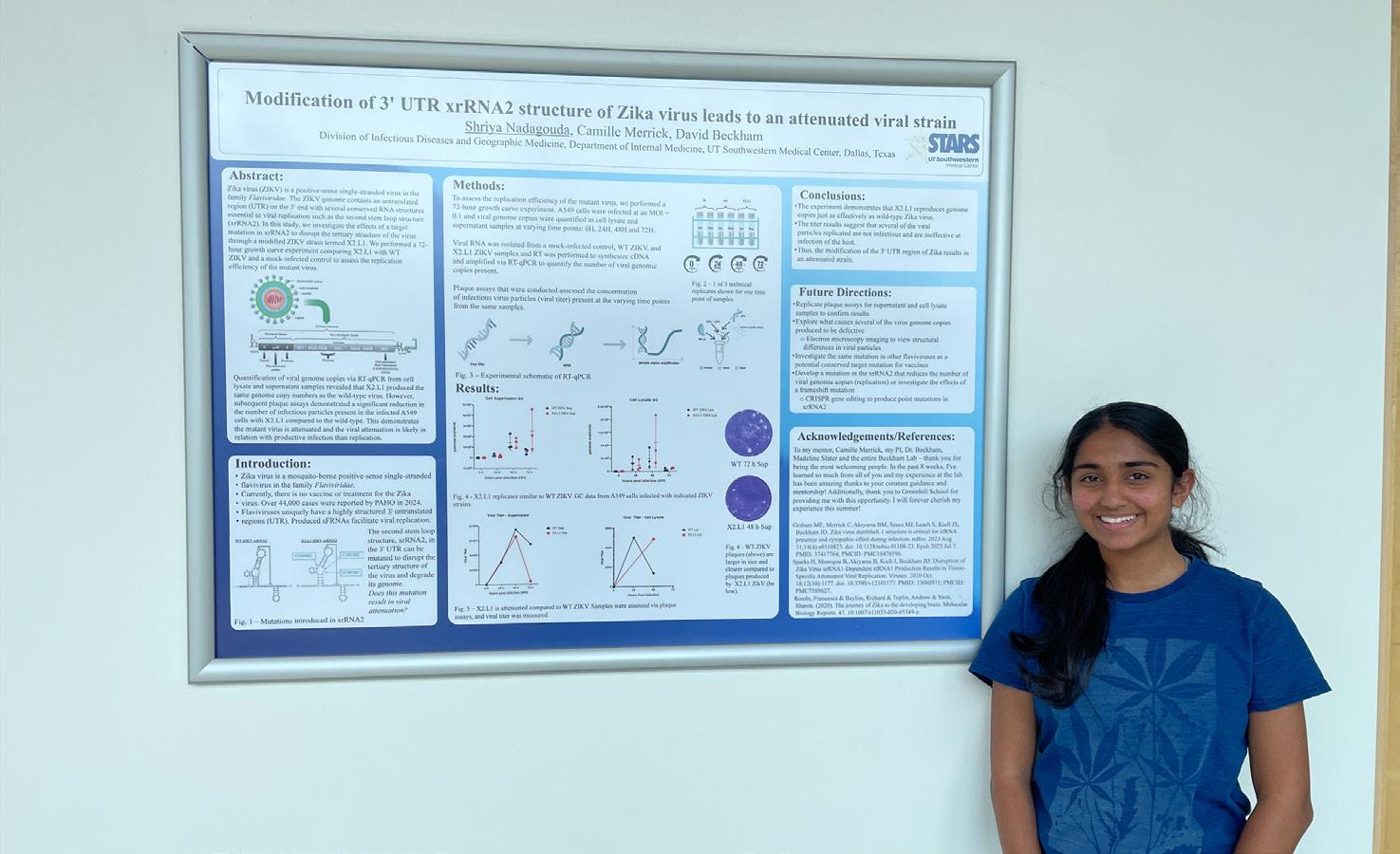
anywhere, GPCR84 goes inside the cell after it’s activated by its agonists or ligands, keys that bind to the protein to trigger an action,” Johnson said.
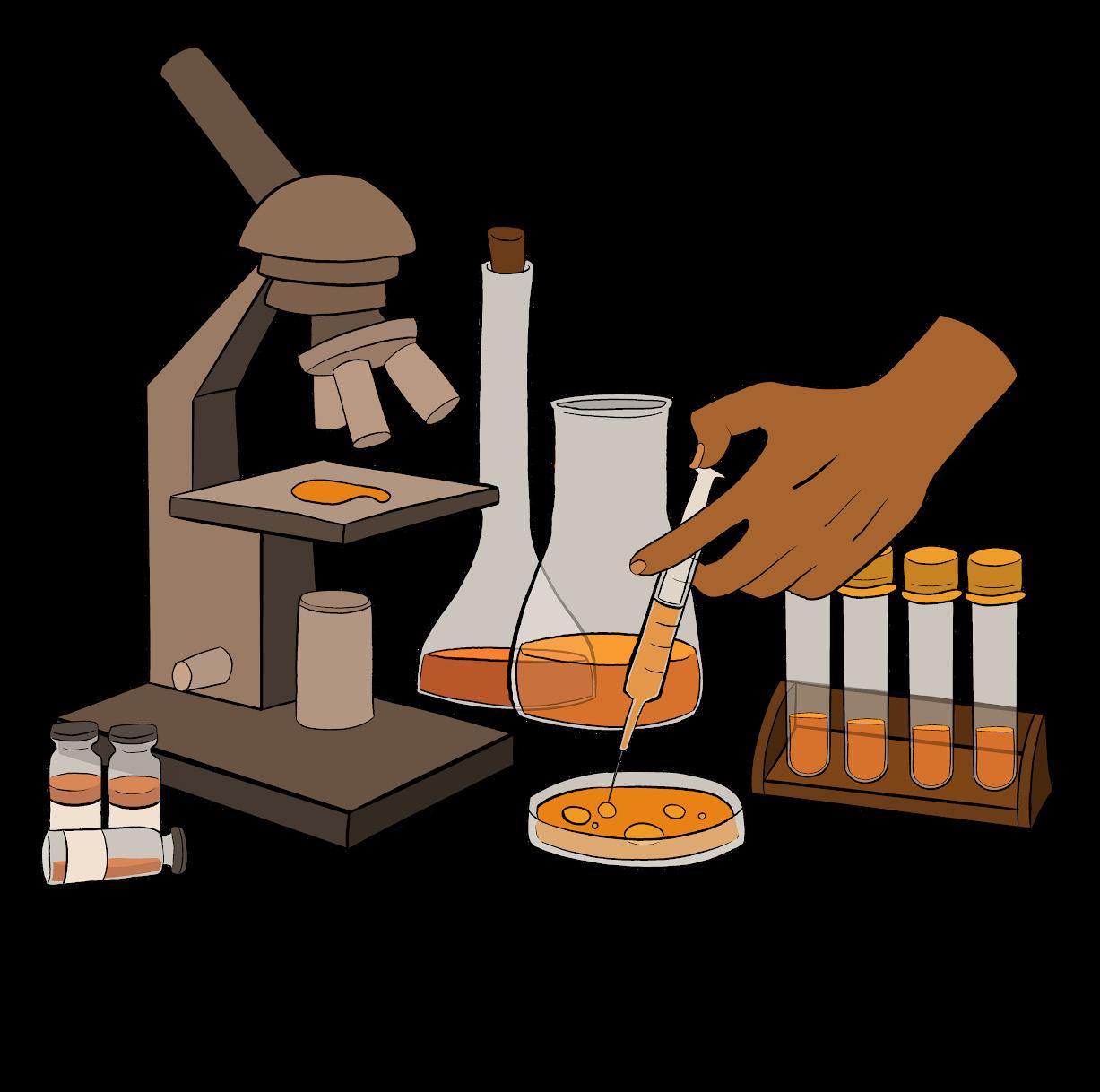
From there, the program generally accepts three students. This year, the third student had a conflict, leaving only two participants from Greenhill.
The application process is designed to give students room to explore their interests, according to Nadagouda, by pairing the students with a lab and PI consistent with their preferences.
“The ones that I ranked as my tops were neuroscience, molecular cellular biology and
The environment quickly fostered strong mentorship and bonding, according to Johnson.
Her research focused on G-protein coupled receptors or GPCRs, a type of protein involved in transmitting signals across the cell membrane. Johnson worked alongside her PI Dayoung Oh and mentor, studying how GPCR84 might affect metabolic regulation.
“My job was to figure out where, if
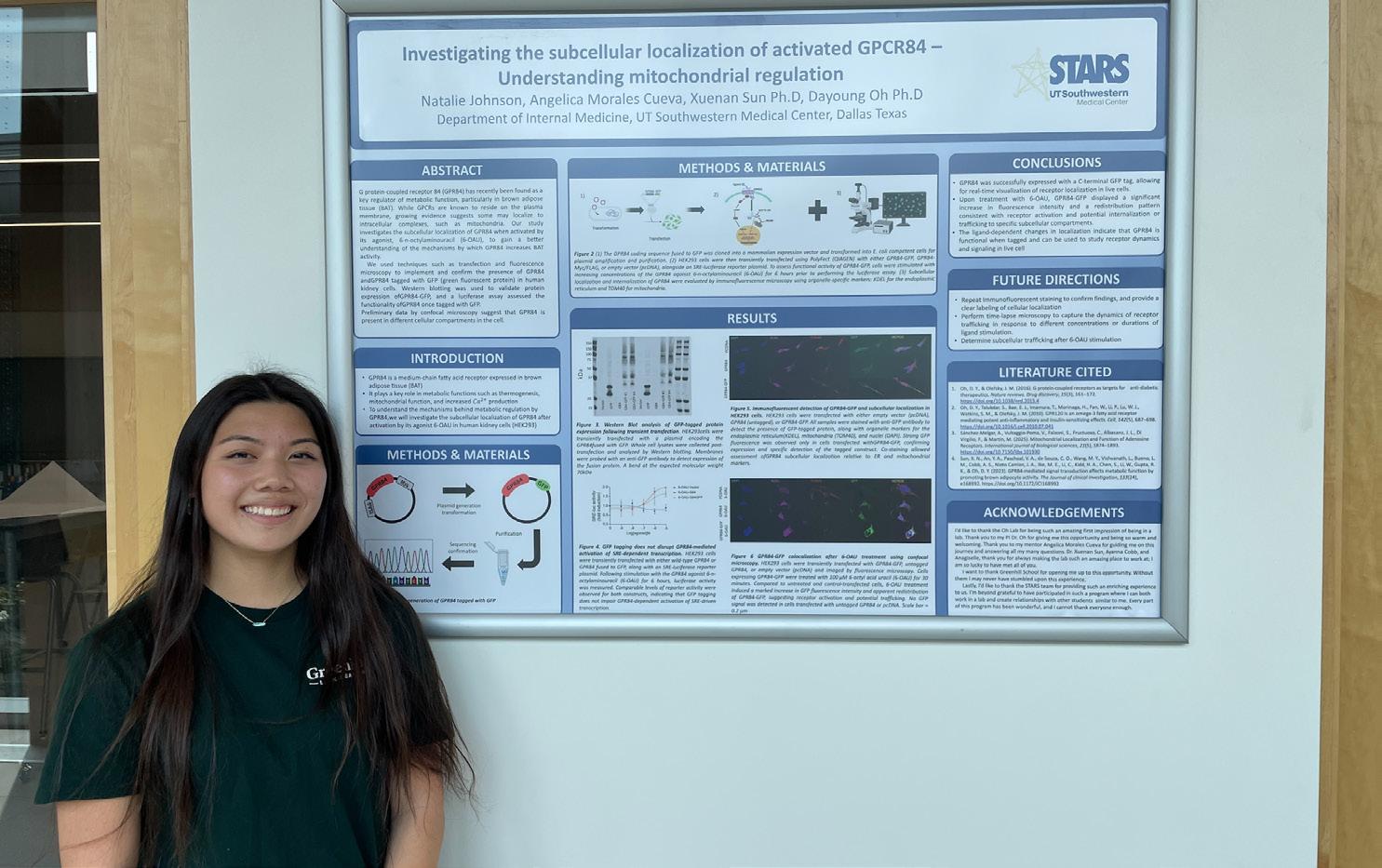
She spent her summer using imaging techniques such as immunofluorescence staining and reading scientific literature to determine where the receptor traveled after activation, often finding herself stumped by inconclusive data and failed experiments.
“You may start out asking one question and barely scratch the surface for those eight weeks,” Kendall said. “Maybe you don’t even answer it but instead generate three more. That really is the nature of the work.”
Johnson says this reality quickly set in, but she came to embrace the trial-anderror process.
“[Oh] kind of pushed me a little bit, which was honestly really scary,” Johnson said. “At times, I definitely got a lot of things wrong, but I think it really
The learning curve was steep, according to Johnson. With more exposure, she learned to solve problems and stay persistent.
“In terms of coming back from failed lab experiments, I was kind of wary at first because I’ve never been in a lab before,” Johnson said. “I was like ‘Oh my gosh! What is going on right now?’ but it’s pretty normal for experiments to fail.”
Johnson found it reassuring to discover where experiments had failed, and she says that Oh and Morales Cueva supported her throughout the process.
Zika Virus
Inspired by presentations given by STARS alumni, Nadagouda knew from her freshman year she wanted to apply to the program.
Nadagouda spent her time this summer studying Zika virus in the infectious disease lab with her PI David Beckham and mentor Camille Merrick.
“In my lab, we mutated the Puerto Rico Zika strain and the three prime UTRs, specifically the RNA structure xrRNA2,” Nadagouda said. “We made three-point mutations, and my project was focused on viral attenuation to see if that strain could become a possible vaccine candidate.”
Throughout her project, Nadagouda and the postdoctoral researchers in the lab met every week. She said Beckham specifically played a big role in keeping her on track.
“He asked me how my research was going, helped me prepare my poster and taught me a lot about the specificities of the
virus,” Nadagouda said.
Nadagouda says she typically put in a six-hour workday, 10 a.m. to 4 p.m., during which she did experiments that took two to three hours each.
Nadagouda says these experiments altered her prior perception of being a researcher.
“A research environment is not like everyone does their own thing,” Nadagouda said. “While some people in my lab worked on the dengue virus or the Oropouche virus, we all came together and helped each other.”
Although newcomers start with less knowledge about research topics and procedures, they have access to a good support system, according to Nadagouda.
“You learn things through lots of years of doing it or just asking other people who have tried it,” Nadagouda said. “It’s a lot of guess and try.”
While gathering data for her final poster, Nadagouda says that she encountered problems with her RNA samples after cultivating and growing them for an extended period of time. However, she was able to turn this setback into a learning experience.
“I think overcoming [mistakes] is just realizing that everyone is going to make mistakes in the lab, and you have to think on the spot of how you’re going to fix it,” Nadagouda said.
Lessons Beyond Science
Though the STARS program is primarily focused on providing high school students with research experience in a professional setting, Upper School science teacher Barry Ide says that he has seen students, especially Nadagouda and Johnson, gain significant life skills.
“I can see their fluency and scientific literacy increase,” Ide said. “You know they’re more comfortable speaking. And I think that’s part of making presentations to their lab group, making presentations to other STARS students. All of that is effort and work, and it pays off.”
Although Johnson doesn’t intend to pursue lab research as a career, she says the experience taught her valuable lessons such as time management, communication and collaboration across various levels of knowledge.
“Sometimes when students go through the program, they’re like, ‘Yeah, this was really cool, and I’m glad I did it, and I don’t think I want to pursue this anymore,’ and that’s also growth,” Ide said.
Kendall says that regardless of the result, the process itself is a learning experience.
“What is the outcome and return? It is literally, not to be cliched, the journey,” Kendall said.
Khushi Punnam, Sasha Wai
Graphic by Lydia Kerridge
Photo courtesy of Barry Ide
LIFE LESSONS: Senior Natalie Johnson spent eight weeks in a UTSW lab learning skills such as time management, collaboration and communication.
Photo courtesy of Barry Ide
SMILING SUCCESS: Senior Shriya Nadagouda spent the summer researching Zika virus under the guidance of veteran researchers at UT Southwestern.
Alyssa and Will O’Gorman’s Final Bow
Ponnambalam, Aashi Punnam
Few Greenhill seniors embody the performing and visual arts like twins
Will and Alyssa O’Gorman.
Will performs on the stage as an accomplished ballet dancer and choral singer; Alyssa creates behind the scenes magic as a set designer for technical theater and multifaceted visual artist.
The O’Gormans started at Greenhill in ninth grade and have each charted unique paths within the Fine Arts Department.
“We’re completely different people,” Will said. “Same background, same family, but what we’ve done with it is totally different.”
Origin Story
Before enrolling at Greenhill, the twins attended Denton Creek Elementary and Coppell Middle School North. They spent their early education years in bustling classrooms and crowded hallways, a stark contrast to Greenhill’s more personal environment.
Alyssa says she immediately noticed the difference between the frenetic pace of Coppell and Greenhill’s welcoming atmosphere.
“When I visited Greenhill, I just liked the community,” Alyssa said. “It felt like people actually wanted to be here.”
Senior Maya Jagsi, a friend of the twins, remembers both as reserved but selfassured early on in their Greenhill lives.
“They were both really quiet at first,” Jagsi said. “You could tell they were figuring out where they fit in, but once they did, they found their people really quickly.”
Will’s Experience
Will’s artistic pursuits began long before high school, when Alyssa’s dance studio recruited him to join “The Nutcracker” nearly 10 years ago. He now dances with the Ballet Ensemble of Texas, rehearsing several evenings each week while balancing schoolwork.
“Once I started taking classes, it just took off,” Will said.
Will’s experience with ballet extends beyond choreography. The art form has shaped his mindset, helping him embrace roles that challenge his self-perception, he said.
“Dance has definitely made me more confident,” Will said. “When I played the Spanish Chocolate in ‘The Nutcracker,’ it was such an arrogant role that I started
jokingly saying I was the best dancer in the room, then I started to believe it.”
After nearly a decade of watching Will develop as a dancer, Artistic Director of the Ballet Ensemble of Texas Thom Clower has seen Will’s curiosity turn into artistry.
“He’s not afraid of trying new things, and because of this he has opened his scope of dance technique over the years,” Clower said in an email. “We discovered last season that his quiet humor is vibrant on stage; he can act as well as he can dance.”
At Greenhill, Will found another outlet for expression in the Greenhill Singers.
“Choir is one of the most free spaces on campus,” Will said. “Everyone knows each other’s names, it’s just one big group of friends.”
Middle and Upper School Choir teacher Emmanuel Espiritu said Will’s leadership and kindness have shaped the tone of the group.
“Will basically has a heart of service — he’s always asking what he can do for the group and how he can make things better,” Espiritu said. “He’s one of those people whose positivity and kindness make everyone else rise to that level.”
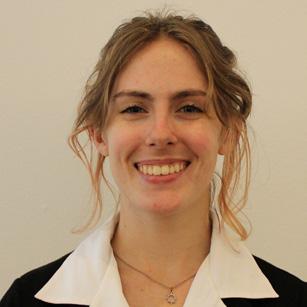
Jagsi says that Will’s quick wit and genuine nature make him an easy person to be around.
“Will is funny, he always cracks really bad, but really smart, dad jokes,” Jagsi said. “He’s someone who can make you laugh on a bad day and someone you can talk to about pretty much anything.”
Alyssa’s Experience
Alyssa officially joined the technical theater program in the second semester of her freshman year, enrolling in the introductory class. But even before that, she often spent time with senior Miles Newman and other tech students during rehearsals for the fall and spring productions.
“I joke that I helped with ‘She Kills Monsters’ even though I wasn’t in the class,” Alyssa said. “I was just lurking like a little freshman until they told me, ‘You can do work if you’re going to be here.’”
Over the next three years, Alyssa took on increasing responsibility in the technical theater program, contributing to multiple productions and assisting with props, painting and set work.
“One of the things that’s so special


about Alyssa is how quickly she developed into a leader by example,” said Upper and Middle School technical theater teacher Will Turbyne. “Her work ethic, her attention to detail, her good nature and spirit were obvious to everyone around her.”
This year, Alyssa is serving as the props lead for the fall musical, “Disney’s Descendants: The Musical.”
“She makes sure everyone knows what they’re doing and where everything goes,” Turbyne said. “Her organization keeps the production running smoothly.”
Outside theater, Alyssa channels her creativity through visual art in Honors 2D Art and Design.
always had a pretty expansive mind and it’s hard to communicate things with words,” Alyssa said. “So, I do writing, I do art, anything that gets my brain out of my brain.”
Alyssa’s peers say her leadership and kindness extend beyond her artistic activities.
“She’s incredibly warm and genuine,” senior Mahri Wenzel said. “I’ve seen situations where most people would stay silent, and Alyssa never does. She always speaks up and stands by what she thinks is right.”
composed and connected.
“They’re very close,” Jagsi said. “It’s not chaotic like a lot of sibling relationships, they just have a really calm, understanding dynamic.”
Future Plans
As graduation approaches, Alyssa and Will are both thinking ahead to what comes next.
“If the economy were perfect, I’d be an elementary school teacher somewhere,” Alyssa said. “But that’s not happening in this economy, so I’m looking at humancentered computing and UX design.”

Turbyne sees Alyssa as well-equipped for whatever direction she chooses.
“Theater kids are always hired and embraced by so many different career paths,” Turbyne said.
“Their ability to collaborate, to handle pressure, to fix what’s broken — those are life skills, and Alyssa has all of them.”
Will plans to major in electrical engineering but hopes to keep dance a part of his life. He says he wants to join a college dance group to stay connected to the art form.
“Dance won’t be my job,” Will said. “But I’ll always keep doing it.”
Espiritu says he hopes Will sustains the spirit of collaboration he’s shown in choir.
“Choir is all about togetherness and working towards a positive goal,” Espiritu said. “I hope that in the future, Will takes that sense of unity into whatever job or career he pursues.”
Life As Twins
At Greenhill, the twins’ work in the arts has taken them in different directions. Their schedules rarely align, with their only ever shared class being Introduction to Improvisation.
Nevertheless, the twins acknowledge a quiet sense of competition.
“We’re the same age, we go to the same school and it’s just a whole bunch of expectations piling on each other,” Alyssa said. “You can’t help but compare each other.”
Classmates like Jagsi note that, despite the pressures of sharing the same environment, the twins remain

Whether they end up on opposite coasts or across the same campus, the twins say their paths will likely continue to mirror the balance they have struck at Greenhill, remaining connected but independently defined in college.
“We are applying to some of the same schools,” Alyssa said. “And if it happens, it happens. But we’re not actively trying to go
to the same school.”
Kate
Photo courtesy of Will O’Gorman
DANCE ROUTINE: Senior Will O’Gorman dances on stage in his Spanish Chocolate costume while performing in the 2023 Ballet Ensemble of Texas’ “The Nutcracker.”
Graphic by Lydia Kerridge
Alyssa O’Gorman
Will O’Gorman
BEHIND THE CURTAIN: Alyssa O’Gorman works on costumes by pinning fabric to mannequins as part of her role as props lead for the upcoming musical.
Photo by Ella Sadka
Greenhill Introduces Artist of the Week
Anew honor announced every Friday gives the Greenhill community a closer look at the work of Upper School artists.
Artist of the Week is revealed in weekly emails to students and faculty that provide insight into the creative process. The award serves as a celebration of creativity and growth, according to Upper School Arts Department Chair Leann Burns.
Burns, who also serves as the campus performing arts building manager, says she got inspiration from the Athletic Department’s Athlete of the Week. With the popularity of these announcements, Burns wanted to highlight artists in a similar manner.
“I just think it’s so cool that they do that, and I always kind of wondered, ‘why don’t we have something like that?’” Burns said.

At the beginning of the school year, Burns put all the electives into a random generator to determine the order in which artistic disciplines are spotlighted. For each class, the instructor will choose either one student or multiple students to be featured.
The announcement email includes a small description of the artist’s work and an accompanying set of images or videos. This could be an inside view of what the class looks like, a picture of the artist or a piece of their art.
Unlike Athlete of the Week, the Artist of the Week is chosen by the teacher rather
than an Upper School vote.
This decision was made because the Fine Arts Department didn’t want the award to reward popularity. Instead, the idea was to highlight students from all areas of the arts, including those who may not always be in the spotlight but who are doing thoughtful, dedicated work, according to Burns.
I just think it’s so cool that they do that, and I always kind of wondered, ‘why don’t we have something like that?”
“I was excited when my teacher told us we were being picked and that we were going to make a video of what our Honors 3D Art class looks like,” junior Julia Deibert said. “I feel like people don’t really know what a lot of electives are like at Greenhill.”
Purpose and Impact
Many art electives take place behind the scenes. Students usually don’t get the chance to see what goes into a performance, a sculpture or a painting, unless they’re directly involved, according to Deibert.
“The process of making art is arguably the most important part, because that’s where all the actual work is done and where the learning is done,” Burns said. “Anything that we can do to draw attention to that amazing work that’s happening on campus every day, that’s the goal.”
Artist of the Week aims to give the community an inside look at the process

and not just the final product. “It’s nice to see what your classmates do,” Deibert said. “It makes Greenhill feel more inclusive.”
“Descendants” Hits the Stage
challenge, according to Turbyne.
Greenhill students are in final preparations for their fall performance of “Disney’s Descendants: The Musical,” opening on Nov. 20 in Rose Hall.
The Disney-adapted musical fantasy centers around teenage children of Disney villains.
“It’s a show that everybody will enjoy,” Upper School drama and theater teacher Valerie Hauss-Smith said.
“At times there will be upwards of 70-plus people on stage at the same time,” said Turbyne. “It’s difficult to kind of create the architecture for the storytelling but also leave space for the dancing and the singing and all the actors that need to be there.”
Each school division rehearses separately until they come together during tech week. Hauss-Smith and the production team have been working with each group to envision how they will all fit together.
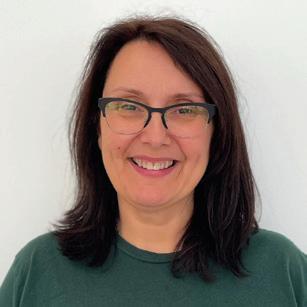
This year’s musical will be even more special because it is an all-school production, according to Upper and Middle School technical theater teacher Will Turbyne. This year presented a great opportunity for a special cross divisional musical to celebrate Greenhill’s 75th birthday, Turbyne said.
Currently, the performance includes 49 Lower School students, 16 Middle School students and 38 Upper School students.
“With Middle, Upper and Lower School all together, we haven’t had this since we did ‘The Little Mermaid,’” Hauss-Smith said. “It’s very Greenhill.”
Logistical Challenges
The large number of students on the stage at any given time poses a logistical
“We have gone through all the numbers and said, ‘in this moment, Middle School participates, and in the next number this is when Lower School is showing up,’” said Hauss-Smith.
Preparation
Students in both the tech crew and cast have been working in specialized groups.
“We’re all kind of working separately,” said senior Miles Newman, a light designer. “Some people kind of mix in between the groups, and they help in different areas.”
Sophomore Arhaan Iyer, who will be playing Ben, the son of Beauty and the Beast, says he has been spending most of his time practicing his lines and “blocking,” which is practicing movements in a scene. With a dance-heavy role, blocking is important, choreography. So, I’m very excited about

Junior Elise Nelson, who plays Maleficent, says she especially enjoys working on her singing parts.
“There’s a lot of work with harmonies and stuff that we haven’t had a lot of experience with before, and so I think that’s really cool,” Nelson said. During tech week, which starts about 10 days before the premiere, students regularly rehearse until 9 p.m., going through each scene together.
“We’re pretty much doing the top of show to the end every single night,” Newman said.
Another important aspect of preparing for shows is bonding. Students are grouped into theater families that eat together on show nights.
“We want to make sure people feel good about being together and feel like it’s a big group, not just isolated cliques,” Hauss-Smith said.
Cate Simpson
CAMPUS CREATIVITY: The first Artists of the Week were juniors Jordy Wilkofsky, left, and Julia Deibert. They crafted ocean-inspired dishes in 3D Honors Ceramics.
Vedant Subramanian, Justin Wu
Leann Burns
Photo illustration by Lylah Pouratian
Photo by Lillian Smith
Valerie Hauss-Smith
Sports
The Hornets’ Rise to Success
like “energy.”
The Greenhill boys volleyball team streaked to a 15-4 regular season record heading into November on the strength of numerous comeback victories. It’s the team’s best start since 2019.
Head Coach Nate Griggs credited the team’s success to strong senior leadership and a foundation of trust among players. This year’s roster included five seniors who have helped integrate two new freshmen.
“In the last few years, we’ve had some guys taking it really serious or wanting to goof off,” Griggs said. “But the balance this year is just perfect. Everyone’s a little bit looser. Everyone’s willing to step up and make those changes, and it’s the five seniors really have set the tone.”
Senior captain Derian Herrmann said this season’s chemistry was a major factor in their success, a quality that showed up in big games such as their two regular-season comeback wins against St. Mark’s School of Texas.
“I think our coach used a great word one time and said we have a form of brotherhood,” said Herrmann. “We play volleyball because we love each other. We want each other to succeed.”
We play volleyball because we love each other. We want each other to succeed.”
Following every game, coaches and players met to grade their performance based not only on skills but also categories
Senior Collin Cannon, a team captain, added that the effort of the coaches allowed them to improve.
“Coach Keith Nannie put a word out at the beginning the season, which was ‘fortitude,’” Cannon said in an October interview. “I think it stuck, because we’ve already had three reverse sweeps, and we’re just now halfway through the season. I think we had one reverse sweep last year.”
Preparation for SPC
The team kicked off the season in the annual Greenhill Alumni Game on Aug. 8. The team tied the volleyball alumni, ending a long run of losses.
“In the alumni game, historically, we lose,” said Cannon. “We carried the momentum to the start of the season.”
The team won its first official game on Aug. 18 against the Red River Rattler Athletic Association, a team comprised of homeschooled students. Then, in a game against St. Mark’s, the Greenhill boys lost the first two sets only to secure the victory by winning the final three.
“We kept saying ‘there’s nothing to lose here,” Griggs said. “Let’s put in everything we can. Let’s keep working harder.”
In the weeks before the SPC tournament, the team focused on refining


Davis Knocke
Iinitially started playing volleyball in middle school because my friends were. Now, there are not many things I cherish more.
their play and carrying their momentum into post-season play.
In an interview prior to the tournament, senior James Gary said the team was perfecting the finer details in their performance.
We kept saying ‘there’s nothing to lose here. Let’s put in everything we can. Let’s keep working harder.’”
“We’re kind of just polishing things up,” Gary said. “We know we can slam the ball down, we know we can put up big blocks and hard serves, but now it’s cleaning up the little things.”
to a strong start
The team also focused on keeping composure during difficult matches, according to Griggs, ensuring they can stay confident no matter the score.
“When we get in a tough spot we want to know we can bounce back,” Griggs said. “Maybe we lose a set, maybe we lose two sets. We’ve proven to ourselves that we can get out of that.”
To succeed, the players tried to improve game by game, according to Cannon. For that goal, team pride was paramount, he said.
“Our biggest motivation is playing for the guys next to us,” Cannon said. “Having the opportunity to bond and carry the legacy of the program is our goal.”
Ode to Volleyball Bus Rides
Over the years, the leadership of older teammates has shaped me into who I am today, as well as who I hope to become. Now, as I reflect on my career, I’m reminded of our thrilling comebacks after being down by two sets and wins against St. Mark’s School of Texas.
But the wins are not what I’ll reminisce on down the line. As Upper School Math Department Chair Darryn Sandler ’95 said in class last year, when you ask an adult what their favorite memory is of their childhood sport, most of them are not going to talk about winning the championship. It’s typially the time spent bonding with the team off the court or field.

The late-night bus rides with the Greenhill boys volleyball team are some of the most heartfelt and joyous memories I hold. There is a level of peace that comes with those drives as the sun sets and stars come out – win or lose The sound of music queued on my speaker while we begged coach Nate Griggs ’09 to take us to Buc-ee’s still echoes in my mind. I’m always brought back to the feeling of the whole bus shaking from the team singing some 2010s hit in the dead of night. Out of all the memories I have of growing up on this team, the bus holds all the special ones that I always seem to recall.
The bus brings back memories of teammates who have graduated. During our last bus ride of the 2024 season, I sat with the seniors knowing this would be one of the last times we shared with them as teammates. I can’t remember if we won or lost because it didn’t matter. I just knew that we were all sitting there together, enjoying that we got this one moment.
Then, I remember when Owen Meschertson ’25 asked me to play “Seigfried” by Frank Ocean. With the song blaring out the speaker, we rode across the dark Texas highway with half the bus asleep. I thought back on how long I knew Owen. To me, he was more than a friend, and more than
a role model of a teammate. He was one of my best friends that I knew I never would have met without our connection through volleyball. I never would have been sitting on a bus getting emotional over this guy I’d known for three years if I hadn’t made the begrudging decision to sign up for the sport all those years ago.
I had a moment of clarity, knowing that Owen and the other four seniors would soon be gone. I knew right then that this sport meant more to me than anything I had been a part of before. If I hadn’t taken that jump in middle school and never joined the team, then I wouldn’t have been hugging that same senior in tears when the season came to an end. Now, whenever I hear that song, I’ll always think of Owen.
This year, knowing it’s my last year, I’ve tried to be just as much of a friend to every one of my teammates as Owen was to me. When I sit on that bus, I try to make everyone else appreciate it just as much as I do. I put my best effort into being a good teammate, a good friend to everyone, just like previous teammates were to me. I bring my speaker on the bus and crack jokes even if I’m exhausted.
As I reach the end of my Greenhill volleyball career, I’ll always be thankful for the long drives to and from Fort Worth, Austin and Houston. When people reminisce about high school it’s always the student section at football games or their senior prank. For me, it will be those long drives. Boys volleyball, you will always hold a special place in my heart.
Graphic by Victoria Gonchar
Nirvan Bhattacharya, Justin Wu
Photo courtesy of Greenhill Communications
STELLAR ATHLETES: The Greenhill boys volleyball team got off
this season. Players described enjoying the team’s “brotherhood” atmosphere.
Photo courtesy of Davis Knocke
BUC-EE’S BREAK: Late-night bus rides are some of the fondest memories senior Davis Knocke, far right, has of his years with the Greenhill boys volleyball team.
Calculating the Over/Under of Teen Gambling Addiction
Nora Ahearn
Former NFL star Tom Brady fills the screen in BetMGM advertisements.
ESPN touts its own branded sportsbook. And the broadcast ticker that once flashed the latest scores for diehard fans also features betting odds.
Now more than ever, sports betting has become almost inseparable from sporting events.
But behind the glitz, the surging popularity of sports gambling may be blurring the line between entertainment and addiction. This is especially true for teens, according to Director of Counseling Kathy Roemer.
“Anything that hits your dopamine reward system is going to potentially be addictive, so I do definitely think that's an issue across the country,” Roemer said. “Teens’ dopamine hits are higher than an adult's dopamine hit, and so they are much more susceptible to getting addicted to it.”
Sports betting used to be illegal in every state except Nevada. Those days are long gone.
A 2018 Supreme Court decision turned the tide, ruling a federal sports betting ban unconstitutional. Now, it is legal in 38 states.
The Texas constitution outlaws gambling, but Greenhill students say sports betting is widespread – even among high school students.
From social media bookies to underground “sportsbooks” that take bets on games, Texans still find a way to wager. That includes some Greenhill students, according to interviews with Upper School students.
Some gambling apps operate in a legal gray area, circumventing the need to bet covertly.
For example, social sportsbooks like Fliff give free virtual currency to users to make bets. Individuals may purchase additional “coins.” If a bet is won, the user receives promotional “cash” they can exchange for real money or prizes.
Senior Syrus Gupta says he doesn’t use these apps, but friends inside and outside of Greenhill do.
“Nobody really thinks they're gambling on those apps, but that's essentially what you're doing,” Gupta said. “And maybe you're not gambling with your own money, but you're still losing and you're still winning and you're just still building that same habit.”
Teens’ dopamine hits are higher than an adult’s dopamine hit, and so they are much more susceptible to getting addicted to it.”
Some apps fall under the category of daily fantasy sports. Players create teams of real athletes for a few days or weeks, competing for cash prizes. Many believe these games include more skill than just rolling the dice.
In 2016, Texas Attorney General Ken Paxton issued an opinion asserting that paid daily fantasy play is gambling, theoretically making it illegal under the state's
constitution. But the state hasn’t attempted to enforce this opinion, effectively allowing daily fantasy games to flourish in Texas.
Since the apps require users to be at least 18 years old, Texas teens often end up using a parent’s ID. Some parents are unaware to the potential harm of this, according to Roemer.
“As someone who is the generation of the parents of the students at the school, I
that propels revenue growth. In recent quarters, in-game bets generated over half of FanDuel and DraftKings’ profit, the New York Times recently reported.
Artificial intelligence is being used to rapidly generate more betting opportunities, which has the potential to bring in even more money for sportsbooks, according to the New York Times.
Meanwhile, public health officials are
ultimately poured most of his summer earnings down the drain.
“I've never been a big sports watcher,” the senior said. “Then during those couple [of] months where I was gambling a lot, I was watching every single football game and even placing bets on tennis.”
After losing large amounts of money, the senior says he realized he had become too emotionally invested, and he feared it

Know what you’re getting into, understand it, question it.
Question, are you being targeted? And why? Why are you being targeted?"
New Club Athlete HPC Requirements
For the first time, the Greenhill High Performance Center now mandates all club athletes to complete the same 15 preseason workouts as non-club athletes. In a recorded conversation, Director of Sports Performance Jessen Houston and sophomore club soccer player Eden Collins sat down to discuss their opinions and experiences with this new requirement.
In general, I think it’s unfair to require club athletes to put in extra work to play their sport. It is really challenging managing outside workouts, classes and club work, while still having to come in the mornings or afternoons to do HPC sessions.
All those statements are very valid. I can understand where a club athlete is coming from with the busyness of their schedule, which is why we’re advocating for our club athletes to pause what they’re doing on the outside. Last year, we created disruption on the field with the exceptions we made for our club athletes. Now the new requirements increase team camaraderie and togetherness while also making sure club athletes don’t overtrain the same movement patterns.
I feel like the bonding reason isn’t 100% relevant because the times I’ve done my HPC sessions, I’ve been with basketball or other sports. So, I feel like it’s really hard to bond because everyone does sessions on their own time.
When I say camaraderie, I’m not just speaking within the team. I mean other sports engaging with each other.
I’m talking about pride in Greenhill athletics.
I want to see you supporting another sports team’s game, and vice versa.
Another thing I’ll say is that the best programs have their best players in the highest attendance, and so if we don’t have those
expectations for our club players, then we’re missing an opportunity to make our programs the best they can be.

I get that, but it feels as though club athletes have to do extra. For me, I have so much film to watch, so many showcases and so many opportunities for club that take up my time, so adding the stress of 15 requirements makes it so much more stressful and difficult to do the things I want to do. Last summer, I did get injured and I’m taking my time building back, so when it’s like ‘oh, you now have to do 15 sessions,’ it just adds so much more stress and responsibility on me.
I cosign a lot of what you just said 100%. We do have to talk about the fact that y’all are young, and that there’s only 24 hours in a day, so I sympathize and empathize with you. But one thing that students have to learn going into adulthood is how to manage time. We have to do a better job of teaching our students how to prioritize. Talented club athletes have a special gift, but with that there’s a special responsibility.
I definitely understand your points better, and I do agree with you. I feel like we both kind of understand where each other is coming from. The one thing I ask is that going forward you don’t put all the work and responsibility for the team on club athletes.
Absolutely, you’ve opened my eyes to some struggles that I will take to the administration for future considerations. At the end of the day, we want to make sure that our student athletes have the best possible opportunity to end their season in the best way. I’m really happy that you took time out of your day to ask me questions about our decision-making process.
Students Volunteer with Lacrosse Nonprofit
Penelope Stone
Two Upper School students say they’ve learned leadership skills while giving back to the community as volunteers for Bridge Lacrosse, a Dallas nonprofit.
The students are junior Leo Meyer and senior Sofi Lanzillotta.
Founded in 2003, Bridge Lacrosse is a 501(c)(3) nonprofit organization that
provides lacrosse opportunities for kids from kindergarten-12th grade in the Dallas and Austin areas. The organization hosts lessons, clinics, camps and more.
During spring seasons, Bridge Lacrosse also fields a competitive team that plays different schools in the Dallas-Fort Worth area, including Greenhill.
Bridge Lacrosse provides many volunteer opportunities for high school

lacrosse players.
Meyer began volunteering in his freshman year, while Lanzillotta began the summer before her sophomore year. They are also both members of Bridge Lacrosse’s Dallas Leadership Board, which operates during the fall season to “foster relationships between communities.”
During the fall season, high school volunteers run practices for around six weeks to prepare for fall tournaments. The practices are held on Sundays from 3:30 p.m.-5 p.m.

“The program is [Kindergarten]-eighth, but it’s split up, so I’m usually with the older kids,” said Meyer.
Bridge Lacrosse also provides summer volunteer opportunities, including hourlong sessions at community centers. During those sessions, volunteers teach small groups different lacrosse skills.
“You can sign up for however many hours you want to do, and you’ll get the kids on their P.E. time and do basic lacrosse drills with them,” Lanzillotta said.
One of the unique things about Bridge Lacrosse is its outreach to communities that would otherwise not be exposed to the sport, according to Lanzillotta.
“It’s been really great to introduce lacrosse to a bunch of kids who have never heard about it before or never played it before and see them get into it.”
It’s been really great to introduce lacrosse to a bunch of kids who have never heard about it before, or never played it before and see them get into it.”
High school volunteers also use this opportunity to connect with others who volunteer with the organization.

“I think it’s a really cool program that they have because it’s the only lacrosse team that services South Dallas,” Lanzillotta said.
“There’s a girl that I’ve been volunteering with for three years now and we’re pretty good friends, and otherwise I wouldn’t have ever met her,” Lanzillotta said.
Lanzillotta says this opportunity helped her develop some of her own leadership skills, like forming connections with the younger kids.
“I’ve definitely learned a lot about how to interact and make sure all my interactions are positive, and how to help kids when they’re upset,”
Bridge Lacrosse helps its volunteers feel part of a community and build relationships with others, according to Meyer.
“It also helps me be a part of the community, and that’s the point of Bridge, to foster a connection through sports,”
Volunteers can see their leadership skills grow and their impact firsthand through watching the kids improve in lacrosse and character, the
“You get to volunteer with a peer group that is very similar to you, and you really get to see these kids actually get better at sports and become better leaders and people,” Meyer said.
Graphic by Victoria Gonchar
Jordan Arbuckle
SERVICE OPPORTUNITY: Junior Leo Meyer coaches young athletes on their technique as a volunteer at the nonprofit organization Bridge Lacrosse.
Photo courtesy of Leo Meyer
Graphic by Lylah Pouratian
Sofi Lanzillotta
Noora Qureshi’s Journey to Collegiate Field Hockey
Junior Noora Qureshi’s introduction to field hockey was passing a ball around in her backyard with her mom, a former collegiate player.
Nearly eight years later, Qureshi has announced her verbal commitment to play NCAA Division I field hockey at the Ivy League’s University of Pennsylvania.
Qureshi began her field hockey journey at age 10 by attending once-a-week, alllevel skill sessions hosted by Lonestar Field Hockey Club. In the spring of 2022, she joined the club’s travel team as a seventh grader to pursue her interest in the sport.
Toward the end of eighth grade, after playing club soccer for four years and club field hockey for two, Qureshi had to choose one sport to focus on in Upper School. Ultimately, as she began to feel burned out in soccer, she chose field hockey and began her freshman year as a forward on the girls varsity team.
Although she had already played the sport for several years, Qureshi says her love for field hockey truly began to grow in Upper School.
“I really like the team culture,” Qureshi said. “I mean, it’s had a few ups and downs, but I really think it’s grown a lot this year, especially. Everyone is really connected.”
Leading by Example
On the Greenhill team, Qureshi quickly became a standout player, according to varsity field hockey Coach Britney Hawkins.
“[Qureshi] is someone who’s just really passionate about everything that she does,” Hawkins said. “I think that she wants to do everything the right way, and she’s really intentional about making that happen.”
Hawkins began coaching at Greenhill during Qureshi’s sophomore year. She says she immediately noticed how Qureshi would go above and beyond, not only for her own improvement, but for her teammates as well.
“She shares the love for the sport and does that really well,” Hawkins said. “I think she’s a huge part of why we’re so successful, because she’s willing to teach and she’s willing to share. It’s always team first.”
In June 2024, Qureshi was selected as one of the nation’s top female players
to participate in the Nexus Junior Championship, an esteemed field hockey tournament for U.S. athletes aged 11-21. The NJC serves as a pathway for players to advance to the U.S. Women’s National Field Hockey Team.
The annual competition requires athletes to undergo a rigorous selection process where they are evaluated based on skill level and performance as they progress from regional training camps to select events. A month after her selection, Qureshi played for Team Atlanta in the under-16 division and won that year’s Nexus championship.
She was selected again in 2025 to play in the under-18 age division of the Nexus competition. Although it was challenging, Qureshi says playing on the team was a good opportunity for growth.
“It is a difficult experience because it’s the highest people playing together, and it’s also people you don’t know, so it’s difficult to connect as a team,” Qureshi said. “Depending on your team, it’s really fun or not fun, but it’s always really great to experience such high-level play and the coaches give you a really great experience.”
everyone else was telling me, ‘Oh, you’re good enough,’ but I didn’t really feel that until I had that ranking.”
It’s like a safety net which helps everyone play more confidently.”
Junior Soraya Sachdeva says Qureshi’s best leadership quality is that she leads by example.
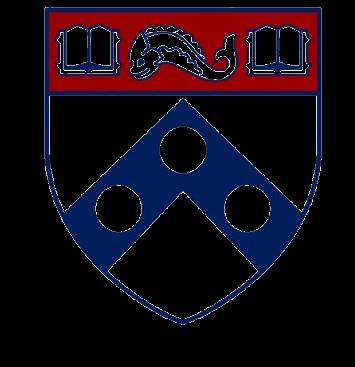
under-19 higher level Orange team.
At Greenhill, team members are able to vote for their captains. This year, Qureshi and senior Samantha Herrmann were elected cocaptains by their peers.
“When we are conditioning or we have a hard practice, she is always the first one to jog it back and say, ‘it’s okay, we can do this, let’s do another rep,’” Sachdeva said. “I feel like there are little everyday moments, especially in practice, where she always steps up and gives 100% when not everybody else is doing so.”
Recruitment Process
As an athlete, Qureshi had always dreamed of playing a sport in college. Once she decided to focus on field hockey in Upper School, Qureshi subconsciously decided that she wanted to continue playing it at the collegiate level.
“I feel like sports are really important in my life,” Qureshi said. “I feel like if I didn’t have sports, I wouldn’t really know what to do with my free time.”
Qureshi says that her recruiting process started toward the end of her freshman year and continued into her sophomore year.
June 15 in the summer before a student’s sophomore year marks the first day that NCAA Division I colleges can officially reach out to high school athletes to express an interest in recruiting them.
I think that she wants to do everything the right way, and she’s really intentional about making that happen.”
In March, Qureshi’s name was added to the Class of 2027 MAX Field Hockey Top 150 Watchlist, a ranking of top high school field hockey players. This accomplishment allows athletes to participate in additional invitation-only events and provides college recruiters with further information about potential collegiate athletes.
“It was really exciting,” Qureshi said. “I felt more confident in my abilities because
Hawkins says Qureshi has been a strong leader for both the varsity and junior varsity teams.
“She’s very, very kind, and I think that’s the number one quality that you really need,” Hawkins said. “[The team] sees her talent, but she also matches it with how she shows up for everyone.”
Senior Sofi Lanzillotta finds Qureshi to be the backbone of the team during games and practices.
“She helps bring the team together by being our constant on the field,” Lanzillotta said. “We know that when we have [Qureshi] in the center midfield, she is always going to be there. Everyone trusts her to get the ball.

Prior to this date, Qureshi says she was hard at work, making it evident to coaches at several colleges that she was interested in playing for their teams. She said she hoped her consistency throughout this process would make her stand out among other recruits and show her commitment to playing collegiate field hockey.
Hawkins says Qureshi’s work ethic impressed college coaches.
“She’s always watching film, she’s always lifting and she’s always playing,” Hawkins said. “She wants to learn, she takes feedback, she adjusts and she never takes the easy way out. I think that’s why she’s so successful.”
That commitment soon caught the attention of college recruiters. After weighing her options, Qureshi found herself drawn to a school that matched both her athletic and academic goals.
Qureshi says she ended up settling on the University of Pennsylvania because of its beautiful campus and the field hockey team’s dynamic. She is also interested in pursuing business, and she says she has received support from the field hockey program to attend Penn’s Wharton School.
I think she’s a huge part of why we’re so successful, because she’s willing to teach and she’s willing to share. It’s about the team; it’s never about her as an individual.”
Hawkins says everyone who knows Qureshi in any way, from her field hockey teams to her academic commitments, believes she will excel as she moves ahead in life.
“At the next level, I think she’s only going to get better, not only because she has those [qualities of dedication, coachability, and constant effort], but because she loves the sport, and that’s a huge part of it,” said Hawkins.
Qureshi says she is thrilled by the journey that lies ahead.
“I’m really excited to see the new community at Penn and also feel welcomed,” Qureshi said. “I just want to keep getting better.”
Photo illustration by Lillian Smith
RIVALRY MATCHUP: Greenhill junior Noora Qureshi dribbles the ball down the field in a game against Hockaday School. Qureshi is a varsity field hockey captain who announced her verbal commitment to play for the University of Pennysylvania.
Aanya Bhoria, Noa Pouratian
Photo courtesy of Noora Qureshi
As President Donald Trump raised the prospect of military or economic coercion over Greenland earlier this year, NATO and the European Union members bristled over his brazen threats of international aggression.
However, Trump’s goal to acquire or negotiate major mining rights within Greenland is not new. It is just the newest manifestation of the administration’s obsession with rare earth minerals.
In 2019, Trump declared rare earths “essential to national defense” due to their use in many military vehicles and weaponry. In 2025, he repeatedly threatened to take control of Greenland, an island with vast untapped mineral reserves. “We need Greenland for national security and even international security, and we’re working with everybody involved to try and get it,” Trump said in an address to Congress in March.
Trump’s tough talk has isolated the United States. “[The U.S. and Greenland] are supposed to be friends,” Greenland Foreign Minister Vivian Motzfeldt has said. “We are allies. Allies don’t do such things.” Greenland is now in talks with the United Kingdom, whom Motzfeldt has described as a “like-minded country,” to formalize a mineral partnership.
Although Trump’s ideal of mineral independence is reasonable, given China’s dominance over rare earths supply, his approach to gaining supply chain diversification is disastrous and impulsive.
In response to Trump’s sweeping tariffs in February, China’s paramount leader, President Xi Jinping, announced tightened controls on rare earth minerals used to make cars, phones and fighter jets. These export controls pose a threat to American manufacturing.
successful enrichment, heavy metal waste leaches into local ecosystems, with effects still detected 50 years later, according to Anne Merrild, Head of Sustainability and Planning at Aalborg University, Denmark, speaking in a BBC interview.
“Damaging the water is really damaging the whole food supply of Greenlanders and their opportunity to have a livelihood based on fisheries and hunting,” Merrild said.
In Africa, conservation groups warn that more than a third of the continent’s great apes are at risk due to mineral mining pollution. Brazilian and German mines have been shut down due to their extensive water use. Other mines are criticized for child labor, effects on local communities and indigenous nations. More than a third of the world’s tailing dams, which are used to hold toxic mining waste, are at risk of doing catastrophic damage to nearby communities if they crumble, according to Reuters.
These are clearly not concerns for the U.S. president who, in 2024, vowed to strip environmental protections impeding the sector’s growth. Meanwhile, the Department of Energy has warned employees in an email to avoid using words such as “climate change,” “green” and “sustainable.”

Only days ago, Xi and Trump negotiated a deal that will push mineral export controls to 2026 if Trump halves the 20% tariffs he levied on China. This puts the U.S. back at square one in the confrontation with China, demonstrating Trump’s clear lack of objectives in trade talks and other policies.
By using haphazard diplomacy and even attempting to strong-arm a fellow NATO ally, Trump has undermined the United States’ international position. By spooking fellow European allies, the administration risks leaving the U.S. even more vulnerable to foreign adversary interference.
Meanwhile, his rosy picture of ubiquitous mineral extraction is also – in reality – a bleak prospect. For every 100 mineral exploration projects, only one might turn into a mine, Simon Jowitt, professor at the University of Nevada, told the BBC in an interview.
In Greenland, minerals are often locked in tandem with uranium, making extraction dangerous. And even with
The move is ironic, considering rare earth metals are used substantially in renewable technologies. But Trump seems to have little care for sustainable technology. Climate change is not a localized phenomenon, and without urgent efforts by the U.S. to curb emissions, scientists predict the world will hurtle toward planetary collapse.
Instead, Trump has been focused on flouting international norms and regulations to serve his personal interests. The Department of Defense (rebranded by Trump as the Department of War) has now become the single largest shareholder in the only rare earths mine in the United States. The DoD has negotiated absolute access to 100% of magnets produced by the mine’s owner, MP Materials, over the next 10 years.
The Defense Department’s mineral monopoly limits resource diversification for renewable companies, prioritizing a ballooning military-industrial complex at the expense of the environment and public health. The world needs a habitable planet more than the United States needs another F-35 fighter jet.
If the administration’s enthusiasm for rare earths was meant to secure America’s future, it has done the opposite. By prioritizing profit over sustainability, current mineral mining directives have isolated the U.S. internationally, endangered ecosystems and extracted more from local communities’ well-being than actual metals.
RHurley
are earth minerals are the invisible foundation of our modern lives.
They power the smartphones in our pockets, refine our oil and support the defense systems that protect our borders. Without access to these minerals, the economy and national security of the United States would come crashing down.
Despite this, the U.S. is almost entirely dependent on foreign nations for these materials. China controls roughly 70% of global rare earth production and 90% of refining capacity, according to the U.S. Geological Survey.
In 2010, after a maritime dispute with Japan, Beijing cut off rare earth exports for two months, crippling Japan’s high-tech industries and sending global prices soaring.
China’s actions should have served as a wake-up call to the rest of the Western world, but it seems to have taken over a decade to recognize this security risk. That’s why efforts to expand rare earth mining, inside and outside our borders, are acts of necessity.
China has continued to curb exports of rare minerals in direct response to the U.S.-China trade war. On Oct. 9, China tightened exports on rare earth minerals and related technologies, requiring government approval for export and use abroad.
This tension briefly eased after President Trump’s Oct. 29 meeting with Xi Jinping in South Korea. The two leaders agreed to a limited trade truce where the U.S. cut tariffs on Chinese goods and Xi suspended China’s new export controls on rare earth minerals for at least one year. But with Chinese statecontrolled firms increasingly acquiring mining and infrastructure rights across Africa and Latin America, America’s longterm vulnerability remains a concern.
same activists who demand an accelerated transition to electric vehicles and renewable energy often oppose the mining required to make that transition possible. Elon Musk’s Tesla vehicles, often hailed as the future for sustainable driving, require nearly 100 pounds of rare earth minerals. Every solar panel, wind turbine and electric car requires considerable amounts of these minerals, including neodymium, dysprosium and lithium.
Global demand for rare earth minerals is expected to quadruple by 2040 under current climate goals, according to the International Energy Agency. That reality leaves two options: either the United States reenters the mining and refining business, or it continues to rely on authoritarian regimes that disregard both labor rights and environmental standards.

The Trump administration is actively seeking new mineral partnerships for the United States. In the case of Greenland, for example, such partnerships could provide revenue, skilled employment and long-term economic stability.
Environmental concerns are significant. Mining rare earth elements is an intensive process that releases radioactive waste and chemical byproducts. The United States, however, is better equipped than any other country in the world to extract these materials safely. America has a moral responsibility to assist other countries who lack the technology or standards to safely extract rare earth minerals, ensuring global demand is fulfilled and the cost of human suffering is mitigated.
There is immense moral outsourcing that defines the hypocrisy of many Western environmental movements. The
The conservative argument is not to abandon environmental responsibility, but to pursue it intelligently. The current administration’s efforts to scale back the Environmental Protection Agency’s budget, staff and regulations are to streamline the permitting process for new mines, governed by the National Environmental Policy Act. The old NEPA approval process, which sometimes took over a decade to complete, has been amended with Trump’s One Big Beautiful Bill Act to expedite the NEPA review. Meanwhile, the national security implications of dependence are becoming harder to ignore. The Pentagon has already labeled rare earth minerals “essential to national defense” and has invested in U.S.-based processing facilities. In 2023, the Department of Defense (now rebranded under the Trump administration as the Department of War) signed a $35 million contract with MP Materials, the only operational rare earth mine in the country, to expedite magnet production in Texas and California. These magnets are critical for F-35 fighter jets, guided missiles and even electric motors used by NASA.
Labeling such efforts as prioritizing profit over sustainability trivializes legitimate concerns of policymakers tasked with securing the nation’s technological independence. We have learned from the recent crises, such as the semiconductor shortage during the COVID-19 pandemic, that reliance on foreign adversaries is a recipe for instability. Diversifying our mineral acquisition through our vast alliance network and national mining is the natural, rational response to the reality we face today. If liberals are truly interested in our survival as a nation, they must recognize that resource independence is necessary for our survival in the age of a U.S.-China rivalry. America cannot lead the world toward a clean energy future or defend its own interests if it continues to outsource the materials that make both possible.
John
Rory Liu
Graphics by Nora Ahearn
the Evergreen Sta�
EDITORS-IN-CHIEF
Nora Ahearn
Getting Your Driver’s License
step.” – Natalie Davidoff
Getting your driver’s license is a milestone in many students’ lives. However, between getting a permit, learning how to drive and taking a driver’s test, there’s a bit of gray area in the process.
To help ease the stress of those who may be getting their driver’s license soon, the Evergreen gathered tips from students in the Greenhill community. Here is what we learned:
“I learned to drive at both a driving school and with my parents. I thought that was a good way to go about it, especially because I also took my test at the same driving school. By also taking lessons with them, I got a better idea of what they were looking for in the test. That also helped my parents be more comfortable when practicing with me.” – junior Savanna Smith
“I did parent-taught, so my mom taught me how to drive.” – junior Briana Solomon
“First, I learned with my dad and then I got a private learning instructor.” – sophomore Natalie Davidoff
“Something that a lot of people don’t tell you before your driver’s test is to look both ways when you pass a residential street.” – Savanna Smith
“The easiest mistake to make on a driver’s test is speeding. You have to always be looking at how fast you’re going because you automatically fail if you go even one mile over the speed limit.” – Briana Solomon
“I believe the easiest mistake to make during your driver’s test is putting on your hazards while backing up because I never tend[ed] to use hazards, so it was a forgetful
W“I got my permit just over six months before my test. I didn’t really start driving though until four months before.” – Savanna Smith
“I was driving for almost a year before I took my driver’s test.” – Briana Solomon
“My biggest tip is to minimize your stress before. Whether that’s practicing parallel parking a lot or whatever, you will make the most mistakes when you’re nervous.” – Savanna Smith
“Practice parallel parking and don’t be nervous,” – Briana Solomon

alking around the Greenhill campus, the beauty of newly planted flowers and peaceful chatter stand out. At the same time, some less pleasant sights and sounds stand out, like the
“Be patient, don’t rush things and always check your mirrors,” – Natalie Davidoff
“Do the test drive, if possible, a couple times before so you can know where the turns are.” – sophomore Jack
“I learned on two different cars. All Star’s cars were very different than the car I drive now. Since their cars were older, I found it harder to drive, which was hard then but I’m appreciative of it now. The other car I learned in is my sister’s, which is similar to my car now.” – Savanna Smith
“I learned on my own car. I thought that was helpful, too, because I took my test in it and still use it now.” – Briana Solomon
“I learned on my dad’s Rivian and it is electric. It is a different shape [than] the car I have now [because my car] is a lot smaller.” – Natalie Davidoff
“I started with my mom’s car and then I got mine, so I switched halfway. My mom drives an SUV and I drive a sedan, so it’s a little bit different. It’s mostly just how high off the ground you are.” – Jack Marshall
“The biggest struggle I faced was scheduling my license appointment. Since my birthday is in October, appointments fill up early. I had to wait until November to get my license, but it was ok because my sister got her license on our birthday.” – Savanna Smith
“I took my driver’s test at All Star Driving. That was the same place I took lessons
“I took my driver’s test at a school near my house. Once I passed, I then went to the DMV to get my actual
“I took my driver’s test at a driving
“The biggest struggle I faced was that I got my license so early, so I was nervous. I’m one of the oldest in my grade so I didn’t really have anyone I could go to who had just gotten their license.” – Briana Solomon
“Parallel parking is difficult, but it is accomplishable.” – Natalie Davidoff
“You can be a little bit nervous when you start, but then you drive for a little while and it becomes better. I experienced that for the first couple of days, when I was 15, but now I’m fine.” – Jack Marshall
Manners on Campus
classroom sounds of students interrupting other students and teachers during class.
As members of the Greenhill community, we are lucky to have a place where we can feel known and accepted. However, our comfort shouldn’t come at the cost of respect.
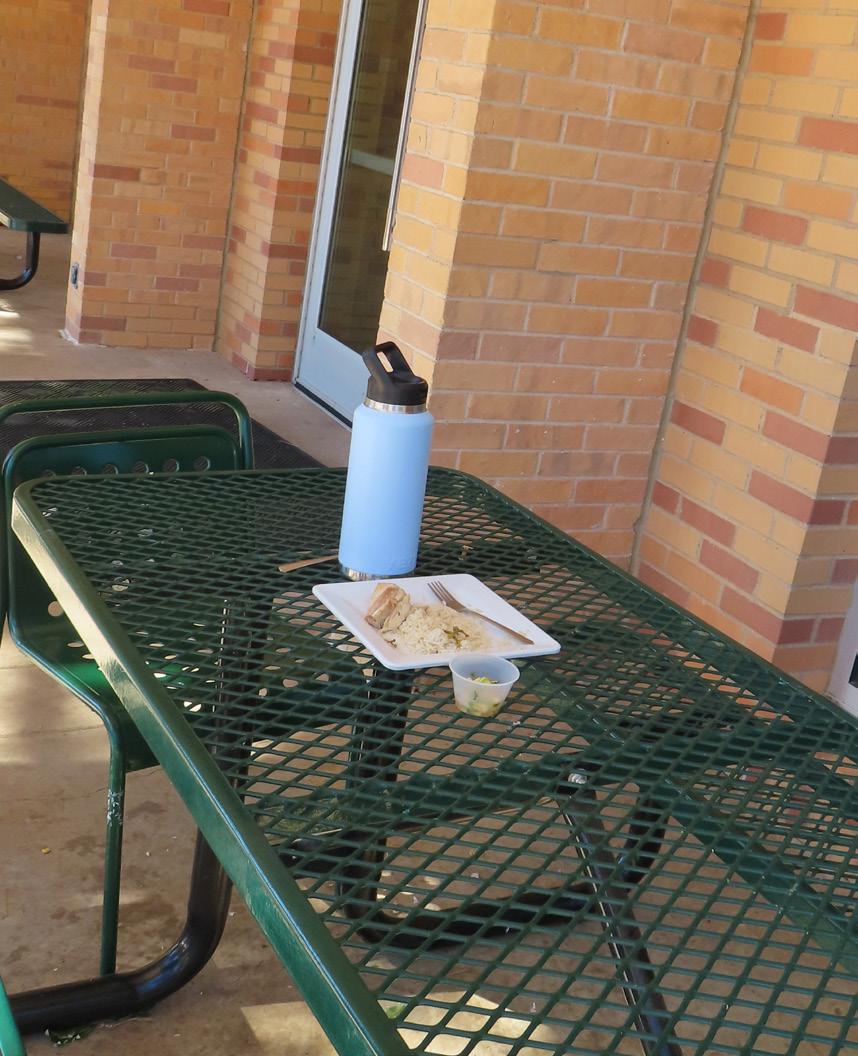
From an early age, many of us were taught to say “thank you” to our teachers as each class wrapped up. Over time, this practice has become habit, and we often don’t even think twice about it. It’s the polite thing to do, but maybe it’s time we think about why this practice was taught to us.
Our teachers at Greenhill work hard on our behalf. When students interrupt, speak disrespectfully or leave the classroom a mess, they negate the gratitude they express by saying “thank you.” Actions speak louder than words.
The classroom is not the only space where we witness disrespect from students. Leaving food and dishes abandoned on cafeteria tables is an act of disrespect. Leaving chairs scattered around the dining hall is an act of disrespect. Despite the efforts of our teachers, many students continue to selfishly treat shared spaces as theirs alone.
The Greenhill custodial team works hard to keep our spaces tidy. However, too many students are used to others cleaning up after them, and that’s apparent on campus.
Just because we don’t see the effects of our mess doesn’t mean that they aren’t there. Why do we see ourselves as more valuable than our peers? Why do we see ourselves as more valuable than our Greenhill teachers and support staff ?
This is a challenge to do better. Even though we know we will be fed lunch every day, that doesn’t mean we should disregard the people who work to make it happen. A simple “thank you for doing this” or a friendly smile can show the Sage dining staff the gratitude they deserve.
No matter someone’s background or what they’ve done in the past, we should honor each other as we do ourselves. This idea of mutual respect is something that seems increasingly lacking in students. Everyone expects the best for themselves, yet they become more hesitant when they have to give their best to others.
Rather than treating peers and teachers purely based on how they treat us, we should raise the bar and re-emphasize manners and respect. Everyone messes up, yet instead of degrading one another, we should support each other. Respect should be the standard. And that can only be achieved if we, the students of Greenhill, make a conscious effort to make this happen.
Kate Ponnambalam
Sasha Wai
John Hurley
EXECUTIVE EDITORS
Rory Liu
Lylah Pouratian
Ella Sadka
Vedant Subramanian
Justin Wu
DEPUTY EXECUTIVE EDITOR
Noor Zaman
MANAGING EDITORS - PRINT
Vivian White
Kaitlyn Yoo
MANAGING EDITORS - ONLINE
Jin Huang
Scarlett Song
Penelope Stone
ASST. MANAGING EDITORS
Aanya Bhoria
Victoria Gonchar
Sadie Werner
DIRECTOR OF PHOTOGRAPHY
Lillian Smith
NEWS EDITORS
Vivian White and Kaitlyn Yoo
FEATURES EDITORS
Cindy Chou and Khushi Punnam
ARTS EDITORS
Victoria Gonchar and Sadie Werner
SPORTS EDITORS
Jordan Arbuckle and Aanya Bhoria
VIEWS EDITORS
Talia Sidikaro and Cate Simpson
STAFF WRITERS
Adrienne Akintola
Ela Battikhi
Nirvan Bhattacharya
Julia Bella Frankfurt
Evan Huang
Elena Kramer
Natalie Ledyard
Meenakshi Mandalapu
Marleigh Massoud
Willa Oza
Noa Pouratian
Aashi Punnam
Nithya Rao
Noah Stinchcomb
Naomi Wien
ADVISOR
Gregg Jones
Response? Opinion? Original Idea? Email the Editors-in-Chief: ahearnn26@greenhill.org ponnambalamk26@greenhill.org wais26@greenhill.org
EDITORIAL POLICY
The Evergreen is an independent, studentrun newspaper serving the Greenhill School community. It is printed six times during the school year. Print circulation is 900 copies. Past issues are archived at issuu.com/ghevergreen. Our staff upholds a code of ethics that values honesty, integrity, accuracy and responsibility. Our mission is to help our community interpret campus, local, state and national events through content written and edited by students.
The Evergreen welcomes letters and emails from readers. We reserve the right to edit submissions for accuracy, grammar and length. The staff editorial represents the opinion of The Evergreen staff, not necessarily that of Greenhill School.
ADVERTISEMENTS
The Evergreen welcomes advertisements, but we reserve the right to refuse an ad. Business inquiries should be directed to Ella Sadka: sadkae26@greenhill.org
CORRECTIONS & CLARIFICATIONS
To request a correction or clarification, please email ahearnn26@greenhill.org, ponnambalamk26@ greenhill.org or wais26@greenhill.org
Elena Kramer, Lillian Smith
POOR MANNERS: Dirty dishes and trash left on tables outside the dining hall.
Photo by Lillian Smith
Graphic by Lylah Pouratian
& Rants Raves
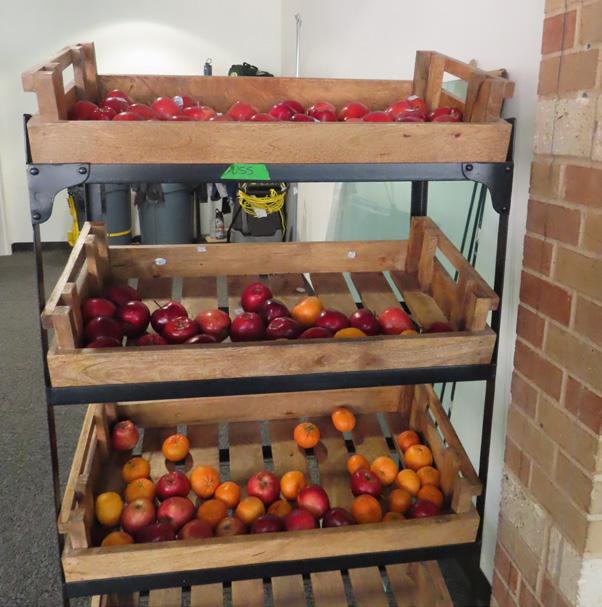
A RANT to the mushy fruits at the fruit stands. The idea of being able to eat fruit at any point of the day is nice, but finding a banana or apple that isn’t almost rotten is often a struggle. Oranges are usually a safe bet, but you never know.

A RAVE to the restart of Bagel Day. The long-awaited return is finally here! No more scavenging for snacks when we can buy the $2 Panera bagels we know and love. Thank you, junior class officers!

A RAVE to the upcoming Thanksgiving break. With two months of school done, our first holiday break is coming up! Not only can we use this time to rest and recharge, but also to spend time with our friends and family and give thanks.

A RAVENT to the transition to winter sports. Although it is sad to say goodbye to the fall season, we are proud of all our athletes accomplished. Winter athletes are ready for their seasons to begin!

A RAVENT to the revised lunch rules. While the new cafeteria has many benefits, it feels like there are too many rules to keep track of – from not being able to stand and wait for friends, to following a singlefile line, to keeping backpacks off the patio adjacent to the dining hall.

A RAVE to “Disney’s Descendants: The Musical.” We are so excited to see the outcome of our classmates’ hard work and watch them put on an amazing performance right before the break!
Elevating the Journey Over the Destination
Kate Ponnambalam
“What math class are you in?” “How many APs are you taking?” “What colleges are you applying to?” “How many likes did your post get?“
Behind these seemingly innocent questions, a sad truth lurks: We high schoolers often feel our worth is tied to these external signs of achievement and approval. Maybe it starts even earlier than high school. When we or our parents applied to Greenhill and received that coveted acceptance, we felt the first thrill of being the “chosen ones” amid the independent school admissions scarcity.
After that acceptance, many of us never stop chasing the fix of academic or social status. High grades, tough classes and social approval signify success, and success means we matter. Perhaps the stress of senior year has thrown me into an existential tailspin, but maybe it is time to question what success truly is and what should make us feel seen and valued.
in the late 1800s. Washington lived in a time when most Americans worked tirelessly just to provide food and shelter for their families. Endurance in the struggle to feed and house families earned the greatest respect, not the extravagance of the meal or the home.

When I looked for wise words about success one definition stood out as especially insightful: “Success is to be measured not so much by the position that one has reached in life as by the obstacles which he has overcome.” Booker T. Washington wrote these words in his autobiography, “Up From Slavery.”
Born into slavery, Washington became one of the most influential proponents of Black education and economic empowerment during the Jim Crow era of racial segregation
So, what does Washington’s view on success have to do with us here at Greenhill? In our bubble where we often define success in terms of the outcome – the best grades, the most Instagram likes, the most prestigious college results – maybe we should start admiring the character we developed and the obstacles we overcome on the path to get even an imperfect grade or less selective college admission result.
Perhaps when our gaze is so transfixed on glittering achievements, we miss the beauty of when someone works really hard and yet falls short of their coveted goal. After all, success doesn’t look the same for everyone; the pressure to chase a single definition can turn meaningful pursuits into hollow ones.
Why does the shift in how we define success matter? Because everyone has a journey and everyone has an opportunity to strive boldly on that journey, regardless of where the journey ends. When we define success in terms of the ultimate achievement, we define ourselves in terms of the prestige of our outcome rather than the heart we grew from the heavy boulders we lifted along the way.
Because success is so closely tied to our worth, defining it correctly liberates us from equating external accomplishments with our internal value. When an A-plus means you’re successful, even an A-minus can make you feel worthless. If you have put in countless hours and sought out a teacher’s or friend’s help, then an A-minus may be disappointing, but, in Washington’s definition of success, your work ethic and connection and care of other people matter far more than a letter grade.
When a friend posts on Instagram, rather than focusing on the number of likes or comments, take time to talk to them about the story behind the post. Even if the experience


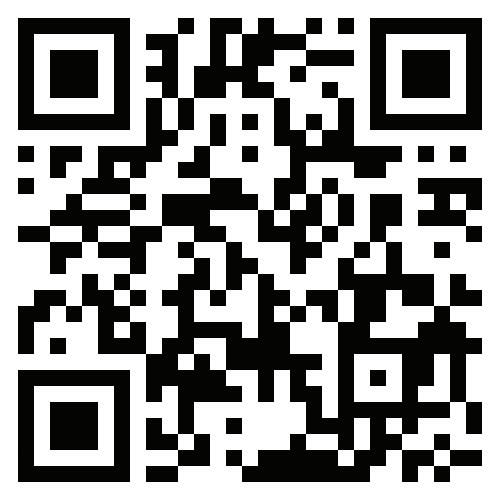
striving boldly regardless of where the striving leads.
Greenhill’s school motto is “per aspera, ad astra,” through hardships to the stars. These words echo Washington’s sentiments. Even as we all have our feet planted on the rocky ground of prestige and achievement culture, may some part of our souls take flight and know the character we build on the journey will place us among the stars.
Graphics by Lylah Pouratian and Kate Ponnambalam

Graphics by Lylah Pouratian
Marleigh Massoud
